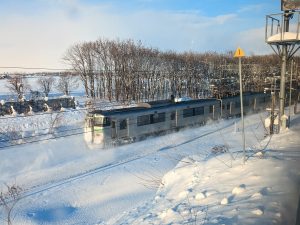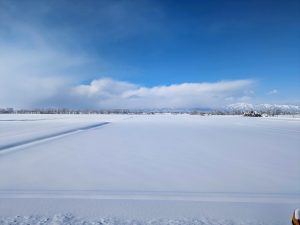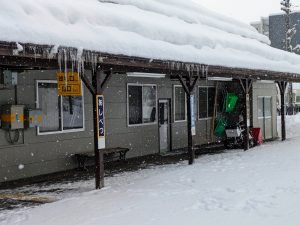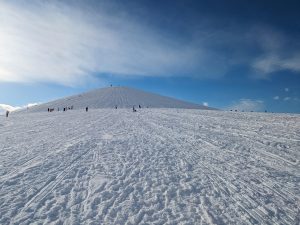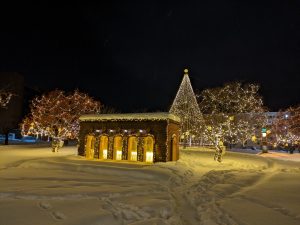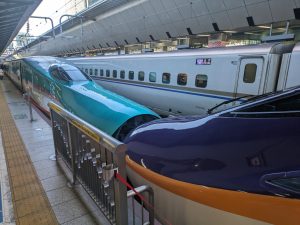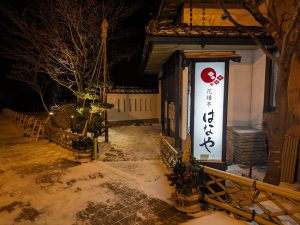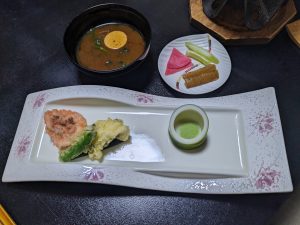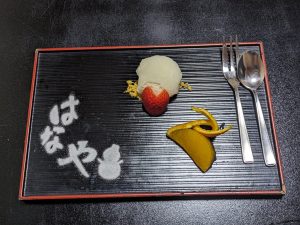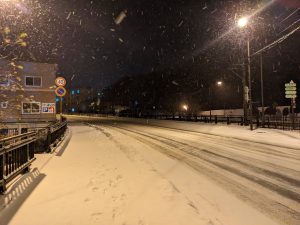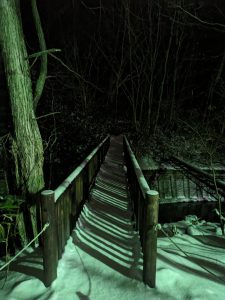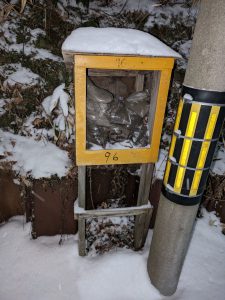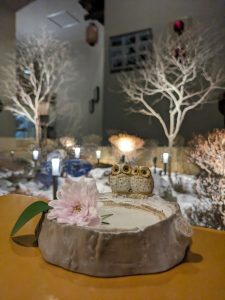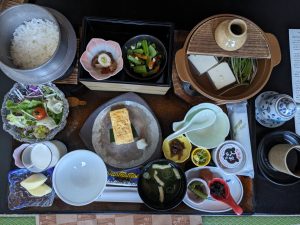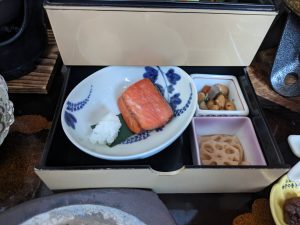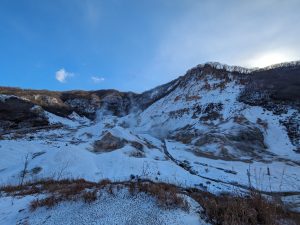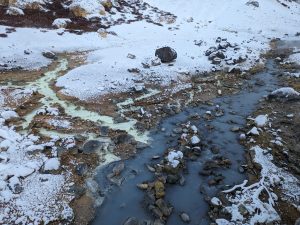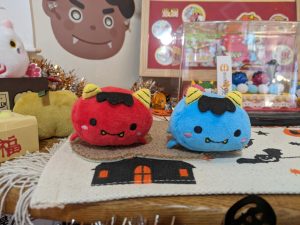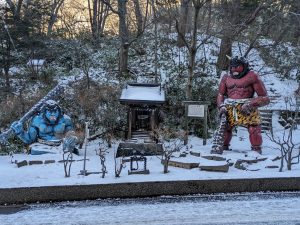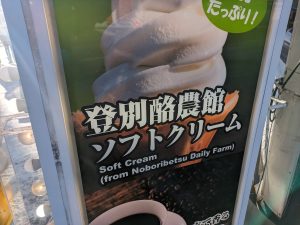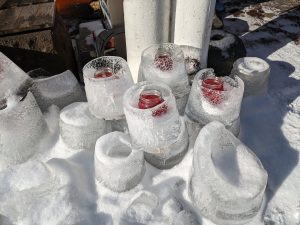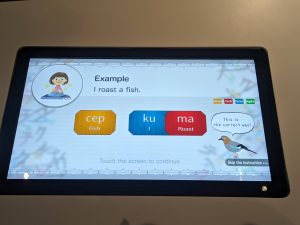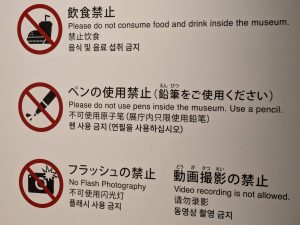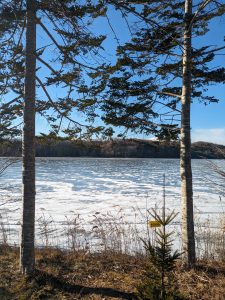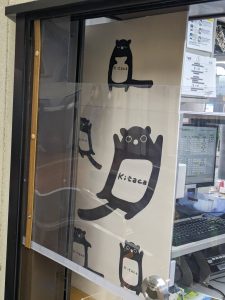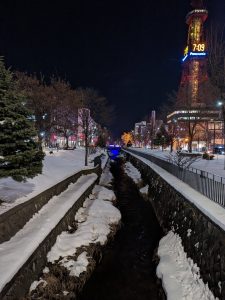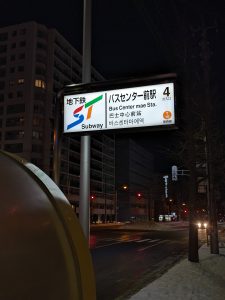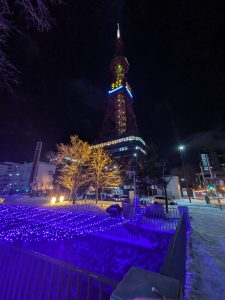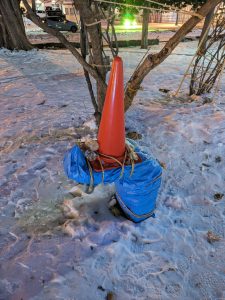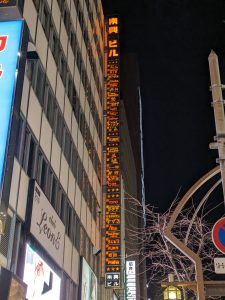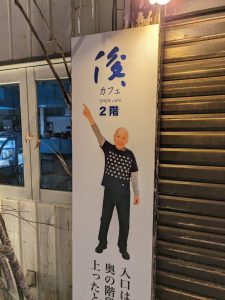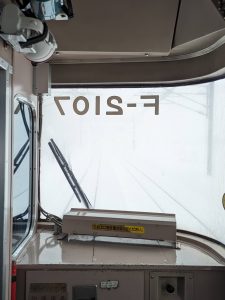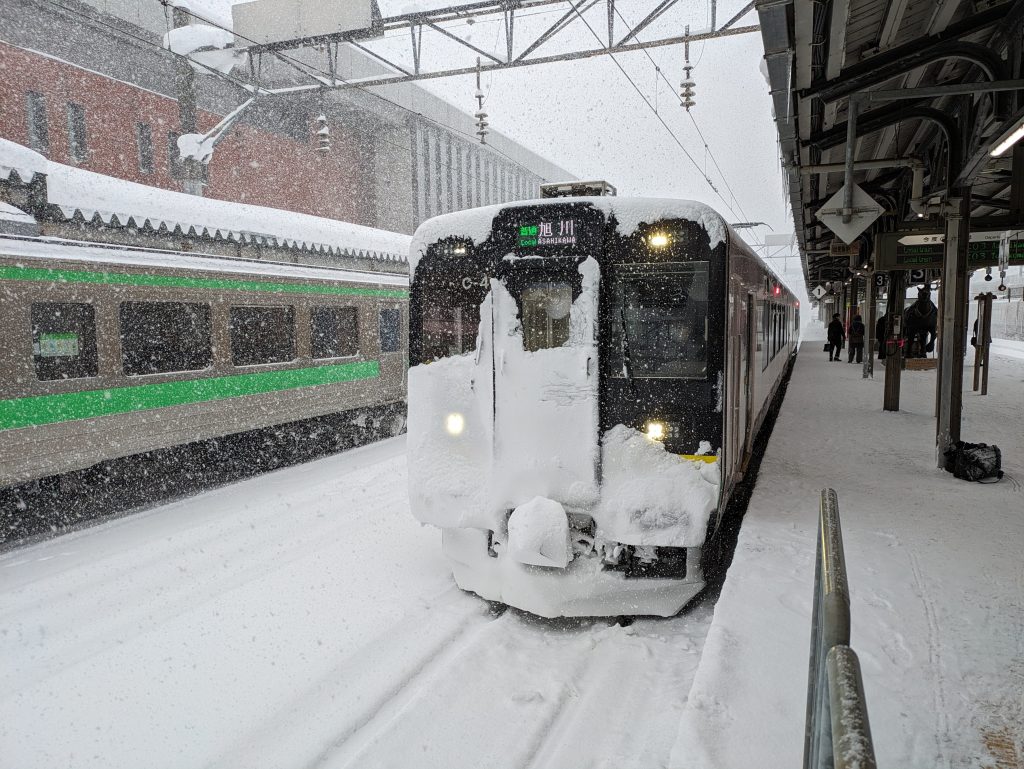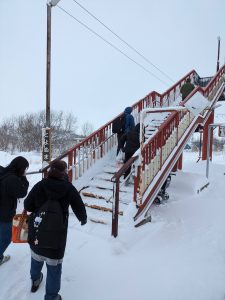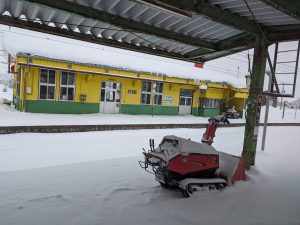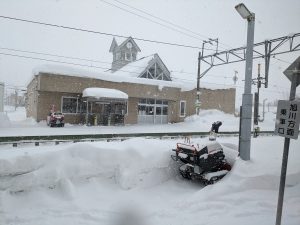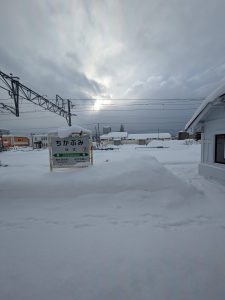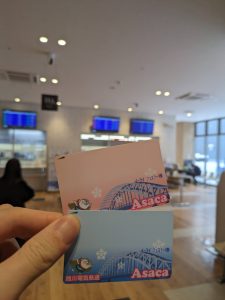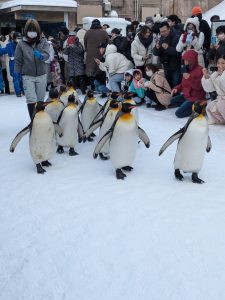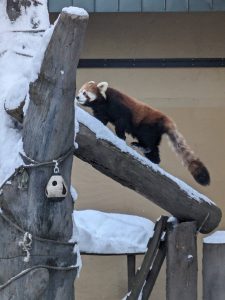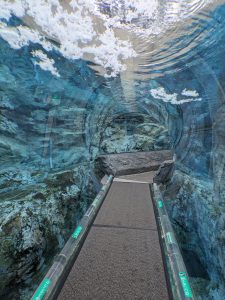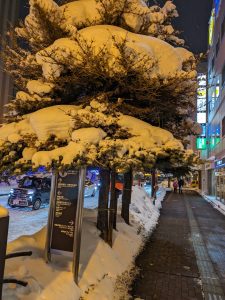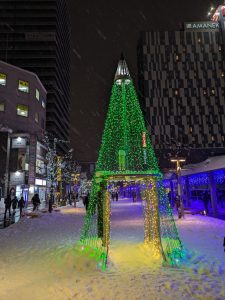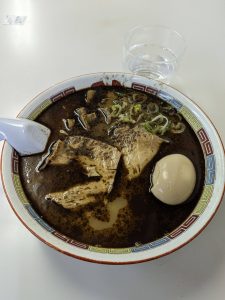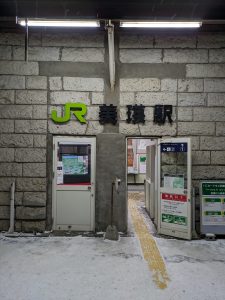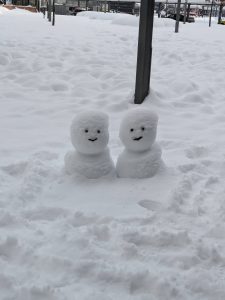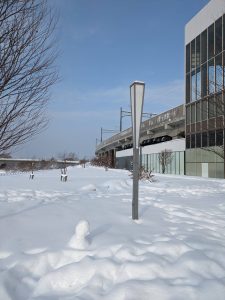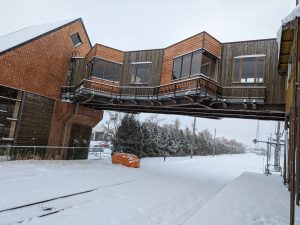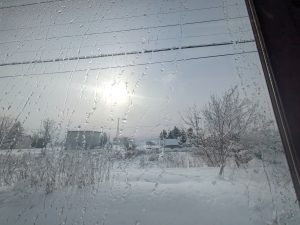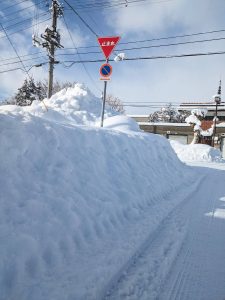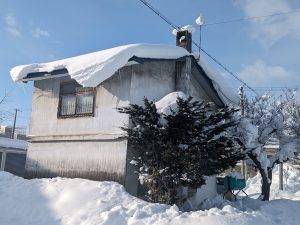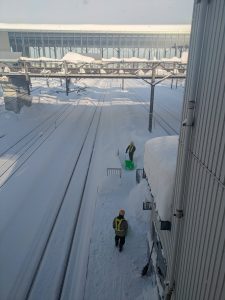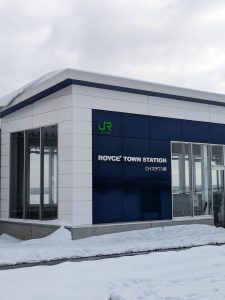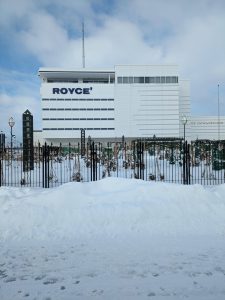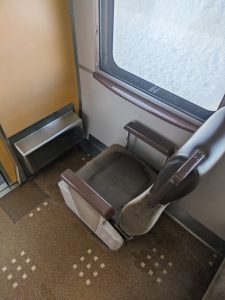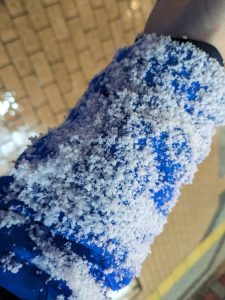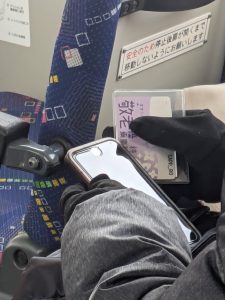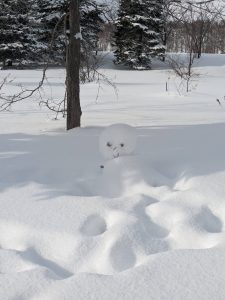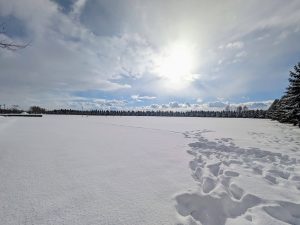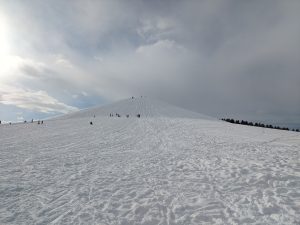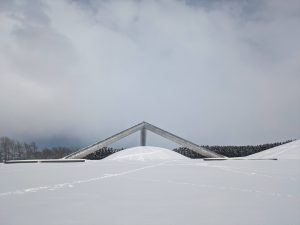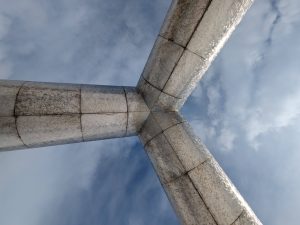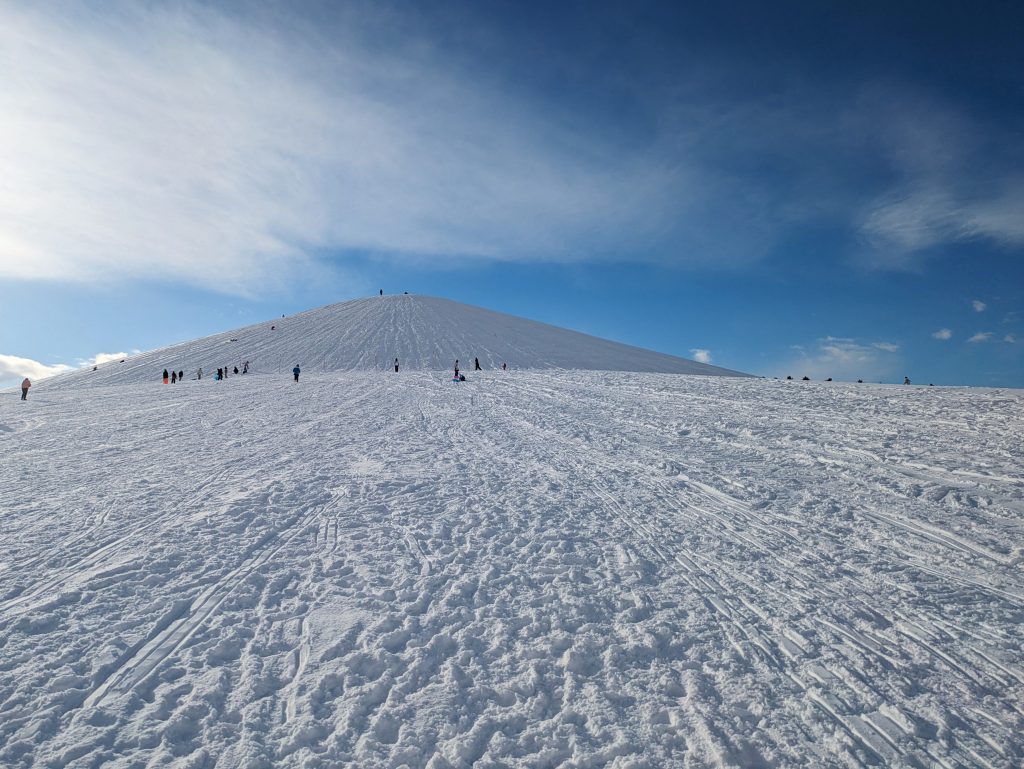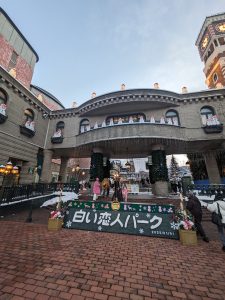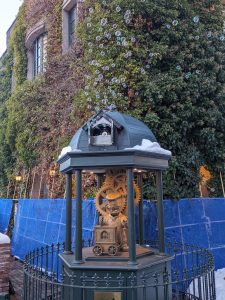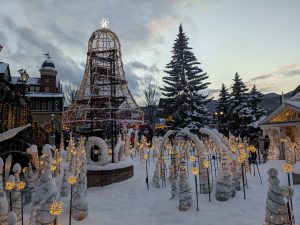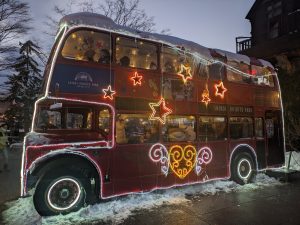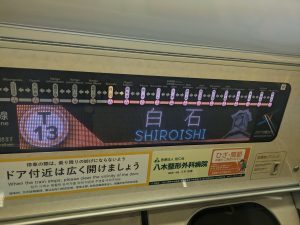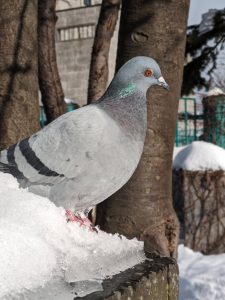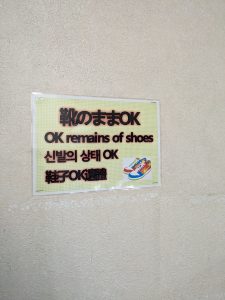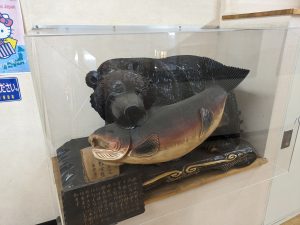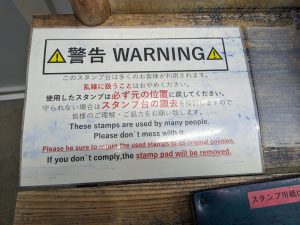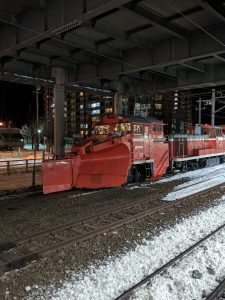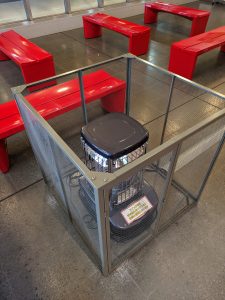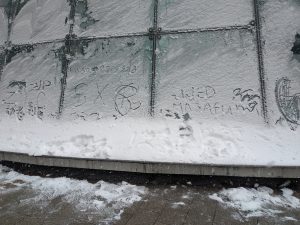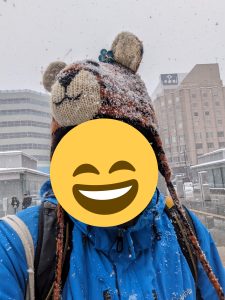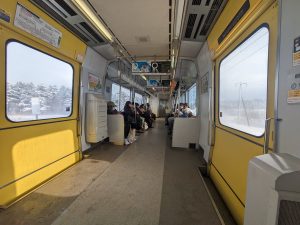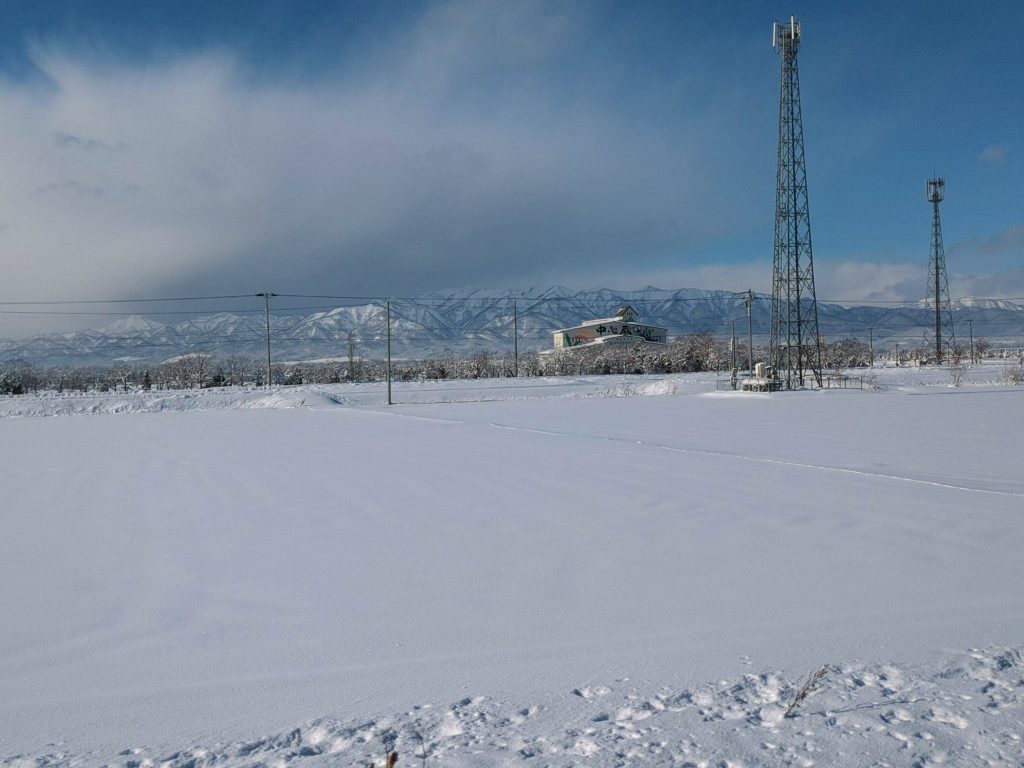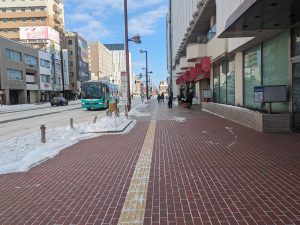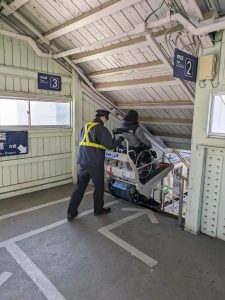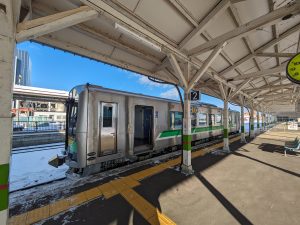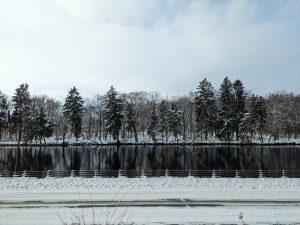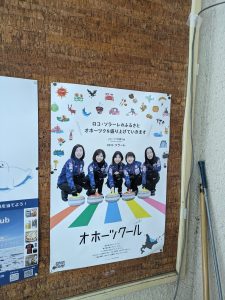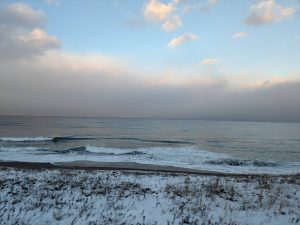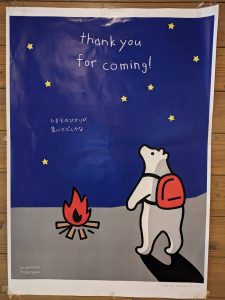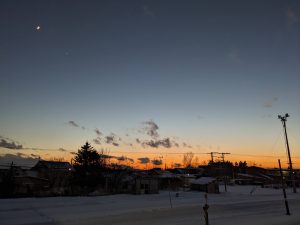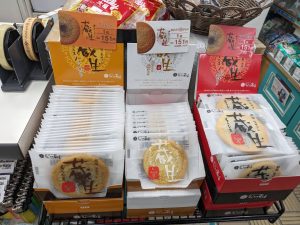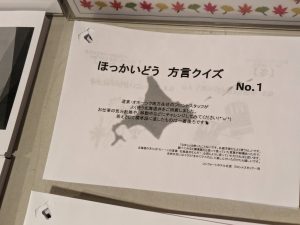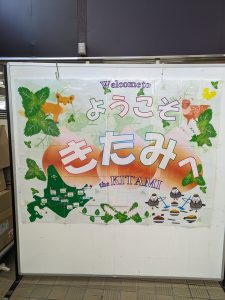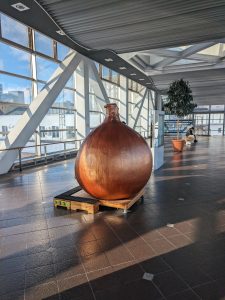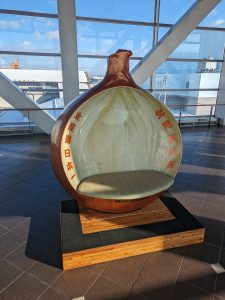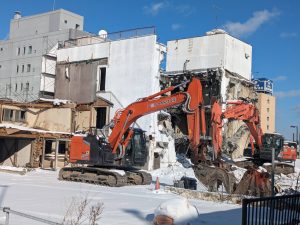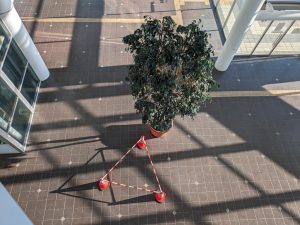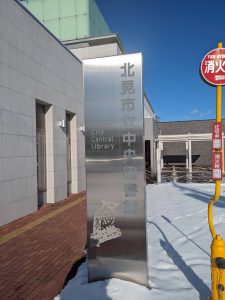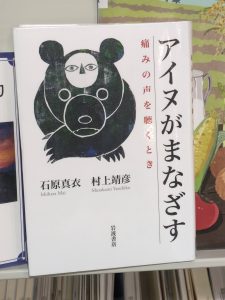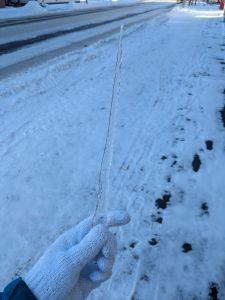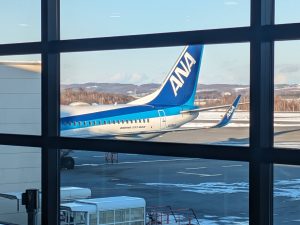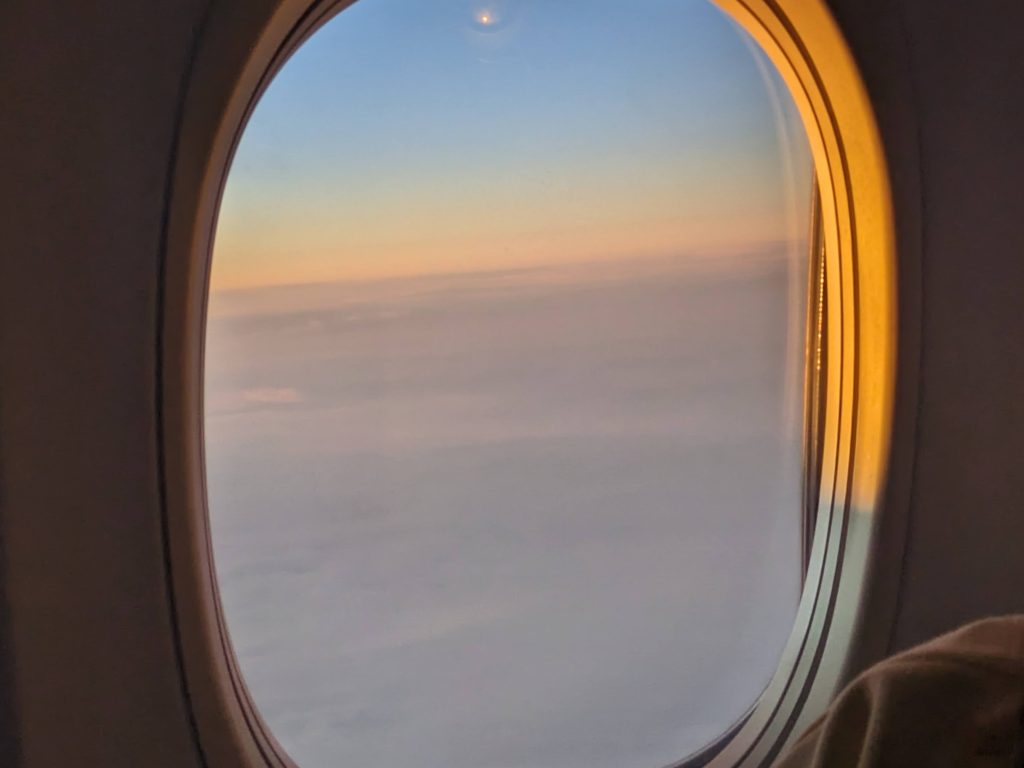Japan is so hot. So absolutely, unlivably hot for a solid four, arguably even five months of the year. But I grew up in the snow – it’s my favorite type of weather, and winter is my favorite season bar none, so for my second year-end holiday period in Japan, I went up to Hokkaido, the last of Japan’s major islands I’d yet to explore, home to some of the world’s snowiest places (and, not coincidentally, also from where I was missing quite a number of IC cards!)
And what can I say? Well, it was cold… and pure magic.
I traveled around with this ticket, the “Hokkaido & East Japan Pass”, which is like the Seishun 18 Kippu I’ve talked about in two previous posts, but just for the JR East and Hokkaido regions. So that means all local trains… the 鈍行列車 donko ressha, or slow trains, the kinds that let you soak up all that great local culture and feeling… and loads of travel time through snowy landscapes:
Partway through my trip, I decided to start asking for stopover stamps, seen in the photo above – a practice that I’ve continued to do with all my long tickets since. It wasn’t strictly necessary with an all-you-can-ride “free pass” like this one, but they’re a fun representation and visualization how much I’ve traveled on a certain ticket. Every station where I alighted got its name marked in a colored oval, and while Hokkaido does have some automatic ticket gates in urban areas, a lot of the island (and severely underfunded, in-debt, still-government-subsidized rail company) is still doing everything by hand, and there’s something quaint about this way of capturing how much benefit I’m getting from their services – and, frankly, JR Hokkaido was wonderful. I’d heard how unreliable trains up north were for delays due to weather, and with services more generally on the decline due to financial problems, but my experience on the network was really exceptional, surpassing my expectations; I felt welcomed by accommodating and kind station staff and impressive operations even through very inclement weather. It comes across as if the rest of the country is oftentimes eager to shut things down at the first sign of wind or rain… but not JR Hokkaido! Go JR Hokkaido!
My trip was nine days – I shot up to Noboribetsu on the shinkansen the first day, with a brief stopover in Fukushima (to get an IC card) and then transfer in Sendai, leaving pretty early that morning to make it to my ryokan by dinnertime. Riding the train up there as opposed to flying was great, since I got to see the country get snowier and snowier as I got more and more north. After that I headed toward Sapporo, but then quickly sped over to Asahikawa the next morning – my beloved, oh man I can’t wait to go back, more on this below – to get some more IC cards, since one of the ticketing offices was closed the entirety of the New Year’s holidays! Then it was back to Sapporo (spontaneously via a different long route) as I figured Hokkaido’s largest city would be the best place to spend New Year’s Eve and the first couple quiet days of the year. I rode around the whole metro and streetcar system, and took a day trip up to Otaru as well. Finally, I headed far east to Kitami to grab my final IC card from Hokkaido and, of course, freeze my butt off too. After a day on the eastern coast of the island in Abashiri, and a quick jaunt to Shari at the base of the Shiretoko Peninsula, I flew home, from a tiny airport with their one-direct-flight-a-day back home to Nagoya. I have way too many photos – I did say snow was my favorite weather, after all… – and so many stories. And as always, it came with a ton of fun signs seen, great food eaten, cozy trains ridden, &c &c. Hopefully you’ll enjoy reading about some of my adventures here!
Friday, December 27
Today’s transit:
7:41 Nozomi 70 Nagoya → 9:15 Tokyo
9:24 Yamabiko 131 Tokyo → 10:42 Fukushima
11:37 Yamabiko 133 Fukushima → 12:04 Sendai
12:17 Hayabusa 19 Sendai → 15:01 Shin-Hakodate-Hokuto
15:20 Hokuto 15 LtdExp Shin-Hakodate-Hokuto → 17:34 Noboribetsu
Today involved heading up allll the way north, from my home of Chubu over to Kanto, up to Tohoku, and then underneath the seabed beneath the Tsugaru Strait to finally reach Central Hokkaido by night. Had some various stops to attend to on the way though…

Literally THE prettiest view of Mr. Fuji [sic] I have ever seen from the shinkansen on my way to Tokyo. Ahh!!!
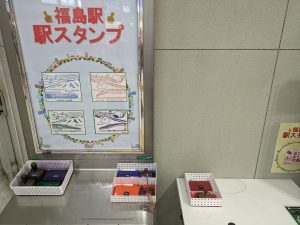
Morioka had lots of stamps, one for each of the different shinkansen train types that stopped there.
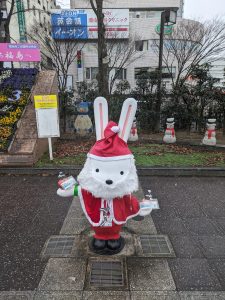
Oh hey, it’s that bunny from Fukushima again who I met over the summer!
Picked up the redesigned NORUCA just as a few flakes of snow started to fall!!!
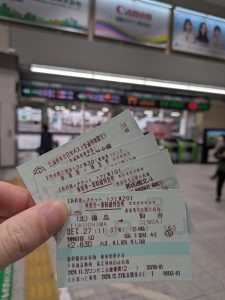
Buncha tickets. I bought them on Eki-net to get some discounts, but then opted to get paper tickets issued.
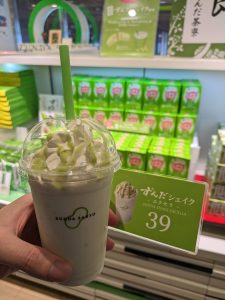
13-minute transfer at Sendai? That is MORE than enough time to run out of the shink gates and get a zunda shake!!! Obviously!!!!!!
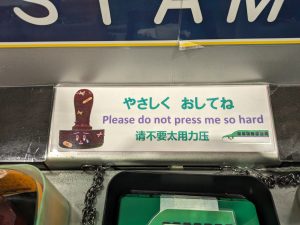
Please do not press me so hard 🥺🥺🥺 (yes, I also took a photo of this in August and completely forgot about it until now when I’m writing this)
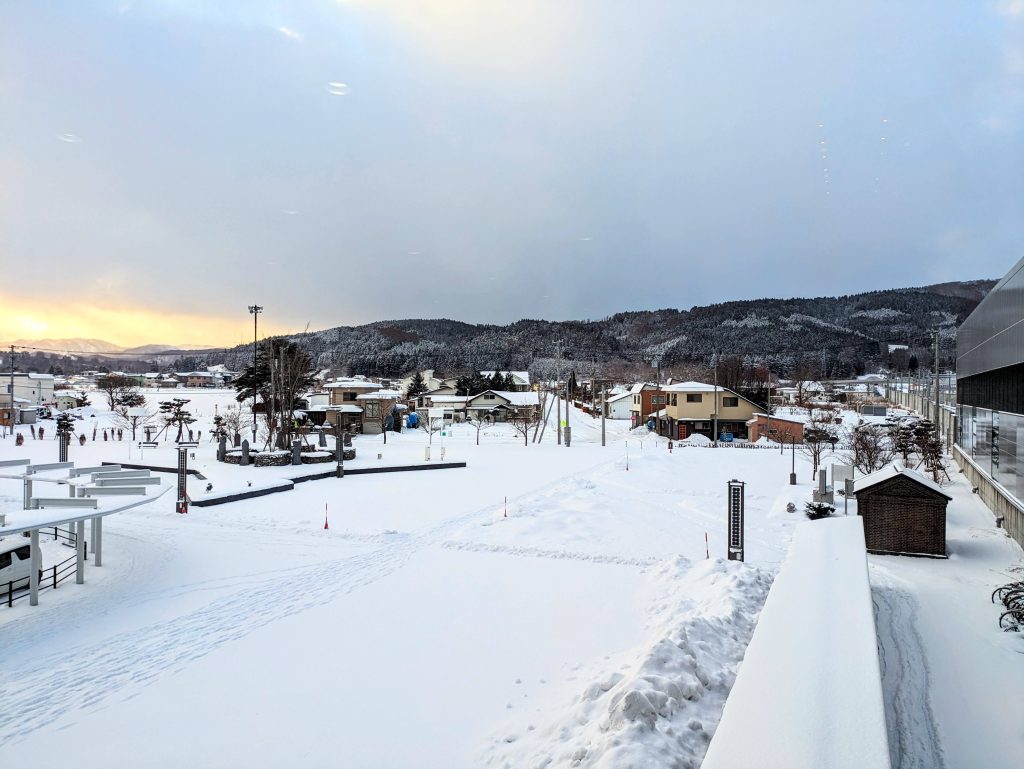
The scene outside Shin-Hakodate-Hokuto Station. This view is when I started getting REALLY excited for the wonderful winter weather that awaited me.

This station is as far as the shink tracks go… for now, until 2038 or whatever when the Hokkaido Shinkansen extension finally gets finished. It’s coming soon™, we promise.
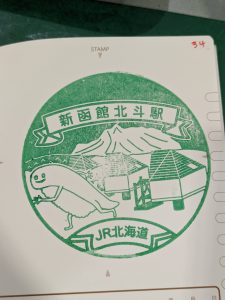
The town of Hokuto’s mascot is Zushihocky, widely agreed to be exceedingly creepy. When I was googling to remember his name, I found an article with the following sentence: “Local officials have admitted that Zushihocky regularly makes small children cry during appearances at promotional events.”
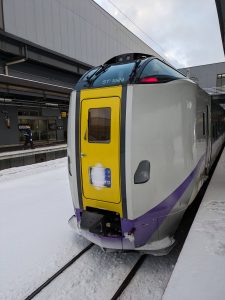
The limited express Hokuto!!! TALLBOI. The trains are so tall, actually, to protect the driver, who sits looking out of the window at the top. Trains hit wildlife a lot in Hokkaido, and drivers in the past have been killed or become paraplegic due to such collisions; their placement here protects them, so any sort of impact won’t crush their legs, at least.
This trip was actually my first-ever time staying at a ryokan! I don’t really like splurging too much on accommodations, I just need a comfortable place to sleep, and ryokan are usually decently fancy – but in searching in the well-known onsen town of Noboribetsu, I was able to find a reasonably-priced one. The Donan Bus departure was well timed to my train’s arrival, although my Hokuto was a few minutes late which caused just a little bit of stress (the driver confirmed to me that he doesn’t wait!) It was a tiny bit farther away from the main built-up area – which was actually really nice, in retrospect – and it was one of the few that accepted one-person bookings. I had hoped to make my “sit outdoors in a warm bath with snow falling all around on me” wish come true… and I did! :)

And as par for the course, ryokan tend to include fancy dinners, usually served to you in your room.
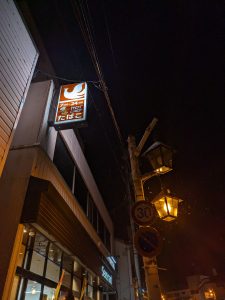
Mogu mogu oishii ne, tanoshii gohan de genki mo mantan, gyutto gyutto anata to S E I C O M A R T e saaaa yukooouuuuu, let’s go!
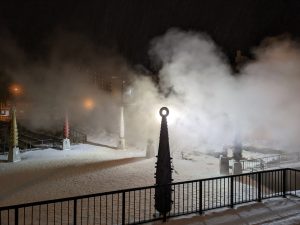
I stumbled upon this place in the dead of night making this dreadful noise (seriously, click to watch the clip, it’s so much more freaky than just a photo) with opaque steam spewing out and looming excalibolgs (pipiru piru piru pipiru pi!) everywhere. Quite a sight! Noboribetsu is famous for the demon gods that were said to inhabit the hot springs.

Jigokudani, or Hell Valley, by night. (Only 8pm or so, actually, but it sure was dark!) There was a lot to walk around so I decided to save most of it for the morning.

I know my chance of getting serially-killed (compound verb) in Japan is very very low, but that’s what everyone thinks about when walking around like this with a phone flashlight, right?

What do you need to be careful of in the dark, cold winter night? Bears? Serial killers? Frostbite? Slipping on ice? No! BEES!!!!
Found a warm flowing spring and makeshift footbath in the middle of the trees. The river flows into Oyunuma Pond, the roads to which were closed at this time of year.
Saturday, December 28
Today’s transit:
16:25 Muroran Line Shiraoi → 16:48 Tomakomai
16:53 Muroran/Chitose Line Tomakomai → 17:25 Eniwa
17:31 Chitose/Hakodate Line (Rapid Airport) Eniwa → 17:57 Sapporo
The plan for today was to spend some time in Upopoy while en route to Sapporo, and then enjoying the evening there.
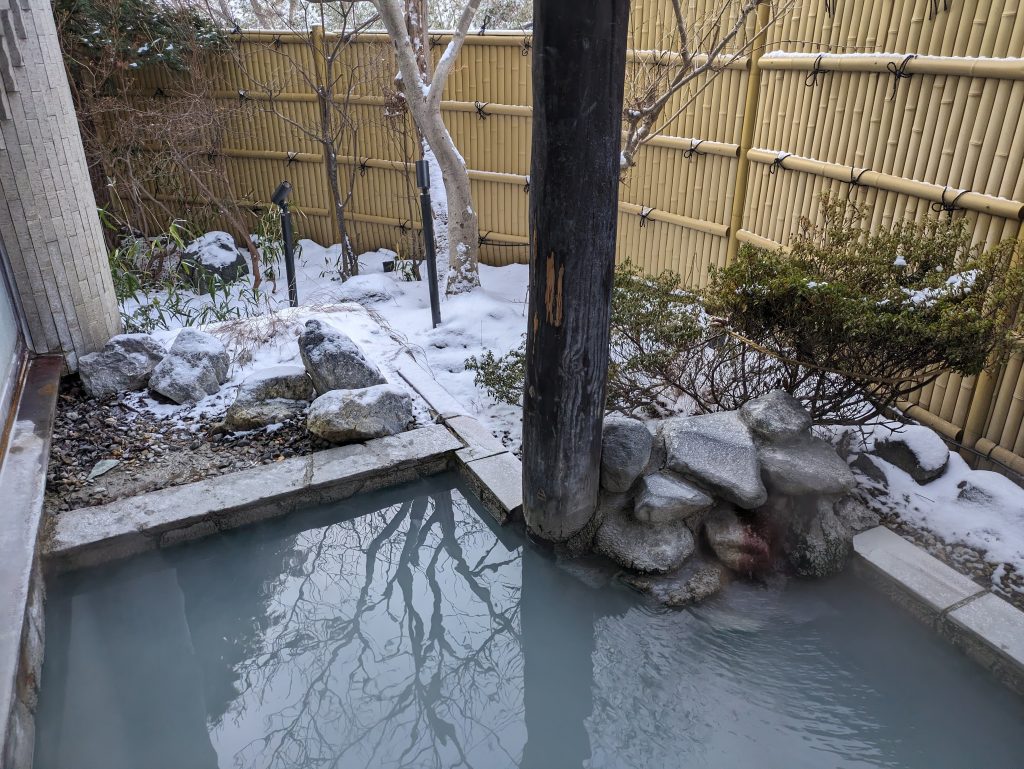
Here was the small outdoor bath. No one around besides me so I took a photo because of how cozy it was, with the steam rising in front of the snow.
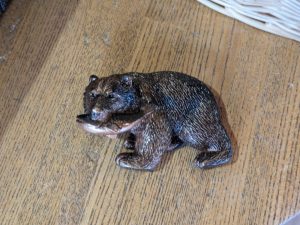
Found a kibori kuma! These are traditional crafts from Hokkaido. I first learned about them through Splatoon.

Noboribetsu Station was SO PACKED. WHAT???? (This morning along with the previous night taught me that place is very popular with Chinese tourists.)

WHAT?????? SOMEWHERE ELSE BESIDES NAGOYA IS USING THE TRANSLATION “WICKET” TO MEAN TICKET GATE?!?!?!?
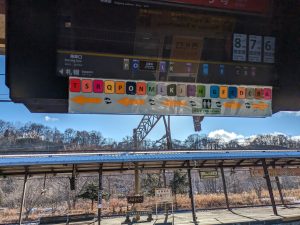
I liked these colorful boarding position indicators on the platform. So analog! You have to wonder how this survives the winter…?
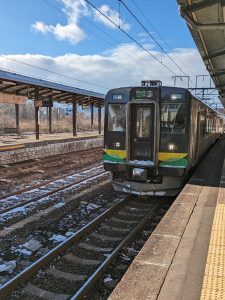
Um, wtf. Where is all the snow. (the southwestern coast of Hokkaido often doesn’t have that much of it!)

No use of the ICcards for customer at Noboribetsu. (There’s lots of this type of signage on JR Hokkaido, unsurprisingly. This map is on pretty much all trains.)
I left Noboribetsu in the morning and headed just a few stops east to Upopoy National Ainu Museum and Park, an open-air cultural museum about the native people of Hokkaido. I’d heard wonderful things (and have since recommended it to many others!) and wanted to spend at least a few hours here before proceeding onto Sapporo, where my hotel for the night was.

The mascot for Upopoy is – OH MY GOD I JUST GOOGLED ITS NAME FOR THE FIRST TIME AND SAW HOW THEY SPELL IT IN ENGLISH – TureppoN. Absolutely incredible orthography. (I’m a huge fan of representing hiragana/katakana differences using upper vs. lowercase in English, just like Echigo TOKImeki Railway does – so I love this.) Anyway, here’s her official bio, which is fabulous: “TureppoN is a turep (giant lily bulb) girl. She lived in the soil when she was little. When she’s grown up, she’ll turn into irup (starch) and delicious food. TureppoN enjoys life at a slower pace.”
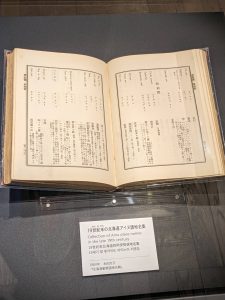
Upopoy was GREAT. Here was a book on place names! Oh man, so many Ainu place names in Hokkaido transformed into downright weird Japanese. A lot of native Japanese speakers can’t actually easily pronounce the kanji of Hokkaido place names – because they use obscure readings in patterns that aren’t found elsewhere in the language… because most are based on or direct transcriptions of Ainu!
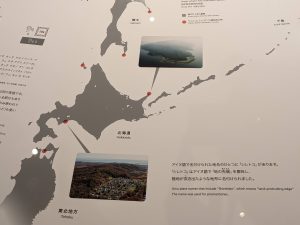
A map showing all the places where the Ainu word “shiretoko” pops up, which referred to promontories (literally “land-protruding edge”). Relevant later on!
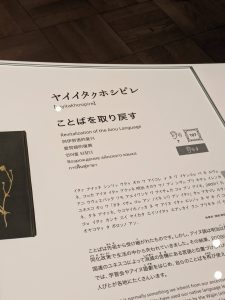
Language revitalization!!!! A lot of the work being done with Ainu recently reminds me of progress with re-introducing and teaching ʻōlelo Hawaiʻi. Both are critically endangered languages.
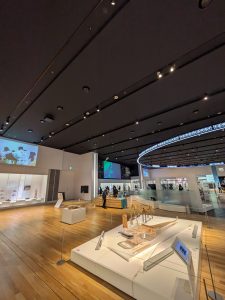
Really liked the layout of the indoor spaces of Upopoy. So many interactive exhibits as well, not to mention workshops, performances, demonstrations, and so on.
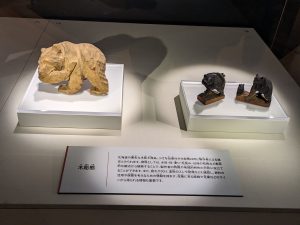
More kibori kuma! I thought this was interesting that this was displayed here because, as far as I’d known, and despite the association people have with this folk craft, Ainu did not carve realistic animals (especially not bears which were considered kamuy!)
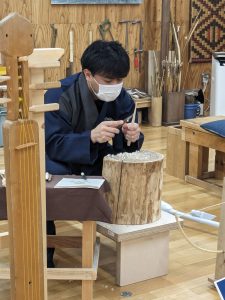
A demonstration of carving wooden tableware. This piece is what he was working on – all from a single piece of wood. So cool.
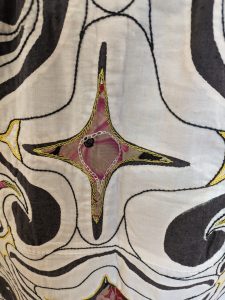
I tried my hand at some embroidery techniques, and then talked with a woman who had spent years making this giant shawl she let me take a close-up photo of. This was the pattern on the back. Their needlework is so unbelievably detailed, dense, and impressive.
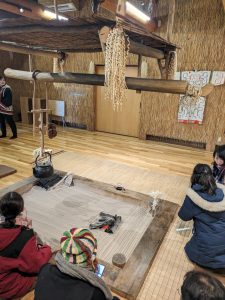
Preparing for a traditional oral storytelling session. She told a story in Ainu and then translated to Japanese.
This photo below depicts the moment that made me a big fan of JR Hokkaido. Hokkaido’s train schedules are pretty sparse; limited expresses come once an hour or so, but local trains only come once every two hours in this area. Our local train was significantly delayed, so the conductor told everyone to get off and said we could all board the limited express that would be arriving shortly on the neighboring track. They let everyone ride it essentially for free, with only their existing ticket and without needing an express ticket, in order to help people make their connections in time and not delay the rest of the network. It was standing-in-the-vestibules-only, and only as far as the original destination of the local train, but it really felt like they were trying to take care of their passengers and ensure people got to where they needed to be. Really awesome, impressive stuff.
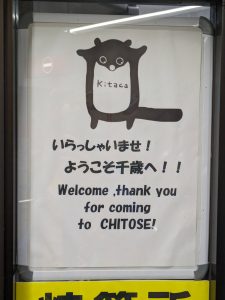
Once we got to the general Sapporo area, between the airport in Chitose and the city proper, trains became a lot more frequent, so I stopped at various stations to collect eki-stamps and then hopped right back on the next train. The Kitaca (Hokkaido’s IC card, which I had already bought earlier in the year) flying squirrel mascot is so cute!!!!!!
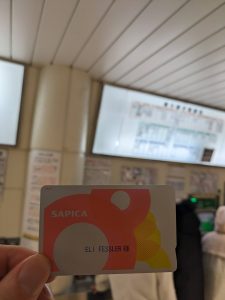
Arrived into Sapporo, and my first order of business was of course to get a SAPICA from the city subway station!
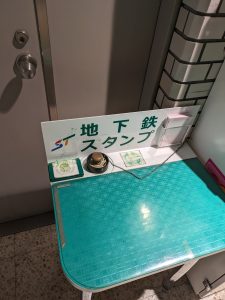
Sapporo City Subway has eki-stamps at all their stations too which is great. Many others don’t (looking at you Nagoya, and Kyoto, and Tokyo Metro…) They even provide good-quality backing papers that say “THE SAPPORO SUBWAY EKI-STAMP” at the top of them lol
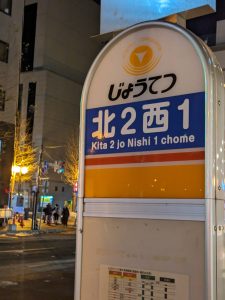
An example of Sapporo’s insane, radial addressing system in the wild!!!!! From the Wikipedia article: “The city center is divided into quadrants by two intersecting roads, Kita-Ichijo and Soseigawa; blocks are then named based on their distance from this point, and farther from the city center, multiple blocks are included in each. The east–west distance is indicated by chōme while the north–south distance is indicated by jō.”
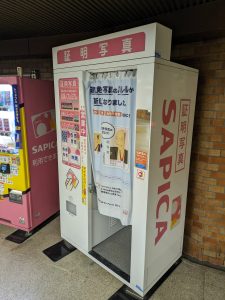
Vending machine and photo booth that support payment via SAPICA, one of the only non-Mutual Use IC cards to have e-money functionality!
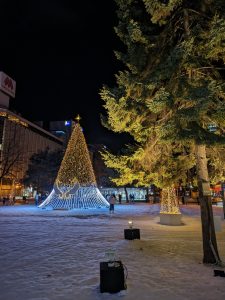
Strolling through this pedestrian plaza with all the lights (Japan likes calling these “illuminations”) was really nice.

Lots of businesses had kadomatsu out for New Year’s.
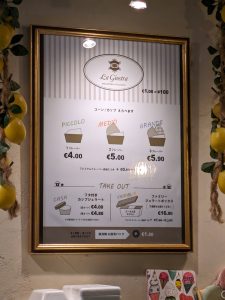
This was MAYBE the best gelato I’ve had in my life???? Apparently the woman who ran it just took a trip to Italy once, fell in love, and wanted to try her hand at making it too. They were going for ~real Italian authenticity~ so they wrote their prices in Euros (lol) with a handy “we actually just mean yen” legend on the side. I asked her if anyone had ever actually tried paying with Euros and she said no?????? Which is shocking to me????
Sunday, December 29
Today’s transit:
Hakodate Line ‐ toward Iwamizawa
11:47 … 12:03 Iwamizawa
Hakodate Line ‐ toward Asahikawa
13:37 Asahikawa21:52 Asahikawa
Furano Line ‐ toward Biei
22:25 … 22:36 Biei
Furano Line ‐ toward Asahikawa
23:11 Asahikawa
On the agenda for today was a trip up to Asahikawa for just one night. As I wrote at the top, one of the IC card issuing companies was closed starting tomorrow for the entire rest of my trip… so this was my last chance to get it!
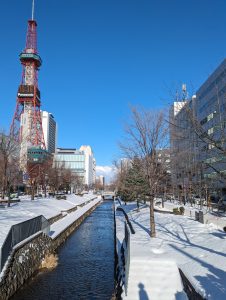
Sappro in the daylight, blanketed by snow, was so nice!! No time to stick around now, though – but I’ll be back in a couple days.
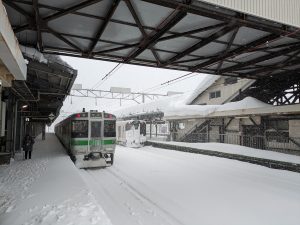
Changing trains in Iwamizawa. Standing under a shady overhang as snow falls all around you is so peaceful and so nice.
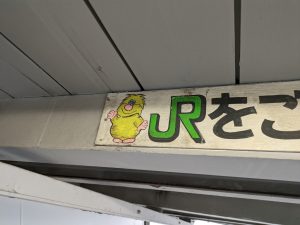
Found this character on an old, weathered sign. Did some research and he’s apparently JR Hokkaido’s little-used mascot, Moja-kun. (The flying squirrel mascot is different – that’s the Kitaca mascot specifically.) The Japanese Wikipedia article claims he’s based on a yeti. I have no clue why he’s yellow on this sign, though!
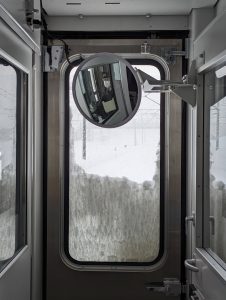
Better visibility now… but was kind of hard to see out the front of this one for a different reason!
I have a lot to write about the two photos below, so I’m doing it inline rather than in the photo captions like I’ve done for most other stuff thus far.
On the left: Many, many place names in Hokkaido are based on Ainu. This one, Chikabumi, comes from cikap-un-i, “bird-existing-place”, apparently referencing a hawk that was known to perch on a large rock nearby. You can also see that the next station on the line, Osamunai, is a sticker covering up something that used to be there – namely, a now-closed station. Chikabumi has been numbered A27, and Osamunai is A25. In the past, two stations were actually in the middle: Inō, which was A26 and closed in 2021, and Kamuikotan, which closed in 1969, way prior to station numbering being introduced on the line. Hokkaido also has a lot of these closed stations.
And then for the photo on the right. I arrived into Asahikawa, walked to the other side of the parking circle to get to the bus terminal building, and successfully bought an Asaca – the local IC card of Asahikawa Denkikidou!! The company used to operate some trains but the lines were abolished in the 70s, so despite their Japanese name referencing railroad tracks, they only run buses now.
But not only did I get an Asaca – I got a PINK ONE. Blue is the regular design, but pink-colored cards were also apparently sometimes issued… I’d seen photos online, and tried super hard to find out how I could maybe get one; the last photo I could find posted online was from around 2020, though a mutual follower on Twitter let me know that he was able to purchase a pink one but not the blue one at some point in 2023. When I emailed the company, they told me only the blue one was for sale… but I figured I might be able to ask around at different windows or offices or try different machines, if I had the time, to see what was available? When I got there and asked to buy a card, the employee laughed a sigh of relief and said “I’m so relieved you speak Japanese, I was so nervous!” thinking I was some lost tourist going up to the bus counter, hahaha – it felt very genuine and honest of him to say that. He sold me the blue one (yay!) but when I asked if they had pink ones for sale, he said, well technically yes, they did have them in back, but were defective so they can’t be used. I asked if he’d be willing to sell me one just for collecting purposes, and he said yes!!!! As long as I promised to not actually use it and screw up their systems. :)
I said hi to the same employee again a couple days later, as I was passing through for a second time (he remembered me!) and when I emailed the company a few months post-trip to ask a niche question about the cards, the email was signed off with “Enjoy your pink Asaca.” It was him, again, and he had apparently remembered my name!!! (That, or, well, maybe I was the only non-Japanese-named person who had emailed them in the recent past.) Talk about customer service! Made me so happy.
After that, I didn’t really have big plans for Asahikawa… and I did have a large balance on my Asaca that would otherwise go to waste… so I decided, sure, I guess I’ll go to the Asahiyama Zoo, a bus ride away. Japan is really bad with animal welfare & rights, and some of the exhibits frankly made me a bit sad, just seeing clearly stressed animals, but I did enjoy the penguins who I just caught in time for one of their daily walks.
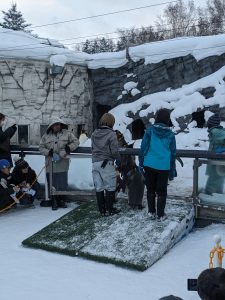
Penguins heading back into their enclosure. They moved this temporary green ramp there so they could more easily get onto the raised ground, and then a team of people came to take it away after, lol.
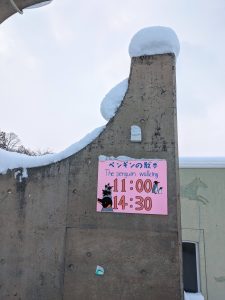
The penguin walking! I also liked this sign for it, which includes info in Japanese, Thai, Chinese, Korean, English, and German. There were a ton of Chinese tourists at the zoo and who came to watch – I was hearing Mandarin around me way more than Japanese. Didn’t hear any Thai or German, though, so I thought that was an interesting combo of languages!
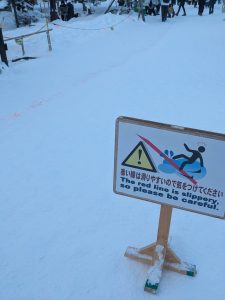
BE CAREFUL!!!! Part of the ground is dyed red with a piece of plastic buried under the snow, which makes it potentially slippery and dangerous!!!! Oh, Japan…
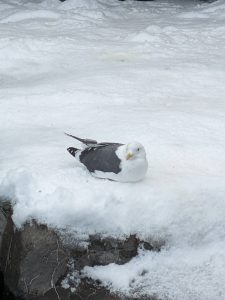
Not part of the zoo’s animals, surely, but this bird was cute too and looked like he was perched comfortably.
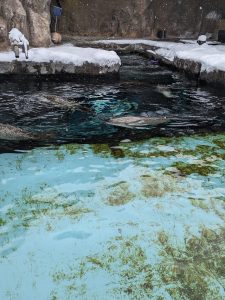
I love otters!!! Fun fact: they’re one of only three animals, besides humans and dolphins, to use tools to a degree of “individual-level specialization”.
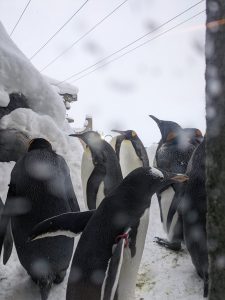
On the other side of the penguin enclosure, seeing where they were hanging out. I made it to the zoo not too far ahead of closing so I was being shuffled out by the staff while I tried to get a look at these guys.
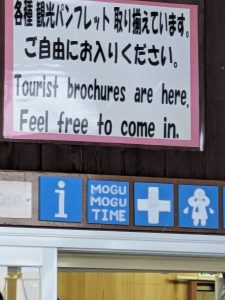
Ah, yes, the four internationally recognized map symbols. Information, first aid, a crying cloud man, and MOGU MOGU TIME.
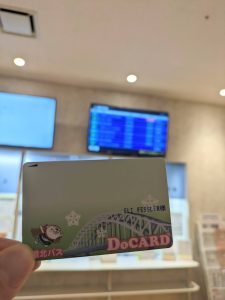
Back from the zoo. Talked with some other tourists on the bus ride who were using a JR Shikoku-issued package-like ticket that actually included zoo admission tickets as part of it!? I had forgotten to take a photo of my DoCARD before, another IC card I bought right after Asaca (literally – the two companies’ counters are like ten steps away).
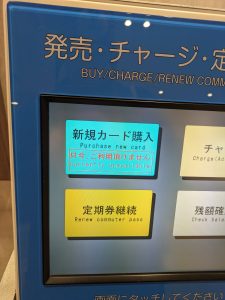
I bought one extra for a friend from the machine, which was apparently the last one that had been loaded in – the button instantly changed to say it was out of stock!
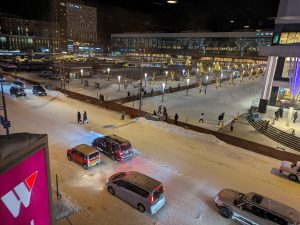
View from my hotel, which was directly across from the station. Most people drive in Asahikawa, and to get to this part of Hokkaido – the front desk was surprised when I said I didn’t need parking during check-in.
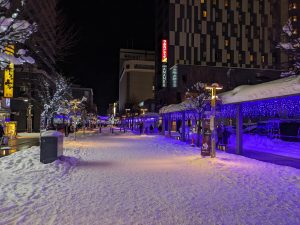
Great little pedestrian walkway/street leading through the main thoroughfare of the city. Loved the way it looked with that purple–blue light on it too!
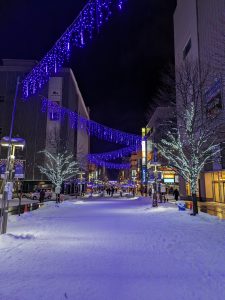
Different view of the same walkway. Sorry, you know I have to have an even number of horizontal and vertical photos in each row in order to make things look good!!! So yes, I admit a couple photos are just kinda filler. :D
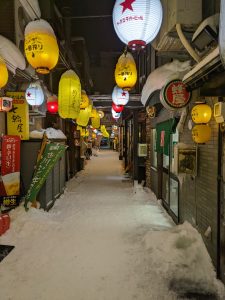
One of my favorite photos from the trip. Loved this little secluded alley in the snow with lanterns and the wind gently blowing.
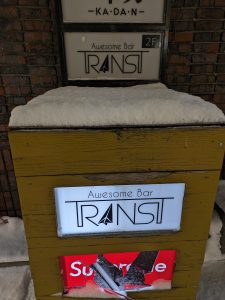
Walked past this on the way home – Awesome Bar TRANSIT. What a name! Sadly, they were closed, or I would’ve considered popping in.

Asahikawa has the BEST ARCADE IN JAPAN because they have two WACCA cabinets and they’re in absolutely perfect condition. And they’re set to allow you to play not the normal three, but seven songs for ¥100. Holy god.
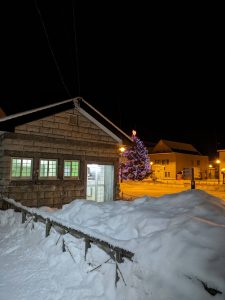
Decided to go for a random train ride at night on a short 1-car to its terminal station and back, and got to see some more snowy nighttime scenery. So many little stations/towns along the way had lights on their obligatory big tree in the center of their stationfront traffic circle.

Arriving back into Asahikawa Station at night made me realize: out of over a thousand I have visited, this is my favorite train station in all of Japan. I’m blown away. It’s by far and away the best-designed one I’ve used in Japan, literally the epitome of mid-sized stations. It has an exceptional layout, signage, and aesthetics – all the natural wood gives it a really warm atmosphere which contrasted especially well with the wonderfully snowy weather outside. Plus there’s public benches and tables for people to hang out or work, and displays of artistic wooden furniture made in the area that the city’s known for. Here’s a photo on the second floor, inside the ticket gates. The trains are one floor up from this. This building made me start to have a favorite architect: Hiroshi Naito.

There’s bathrooms both inside and outside of the ticket gates, and lots of exits on the first floor facing all directions, coming off of the rectangular donut-shaped atrium around the inner area, pictured here – with the ticket office connecting the two sides in the middle and the elevated platforms above everything. It not only houses a konbini (expected) and soba shop, but also a post office, tourist information center, a small Ainu ethnographic museum… plus location-wise it’s right next to a gigantic green park and garden overlooking the river – though that was all blanketed in snow for me, obviously! To top it off, at night, when I took these photos and hardly anyone was around, they just absolutely BLAST smooth jazz music.
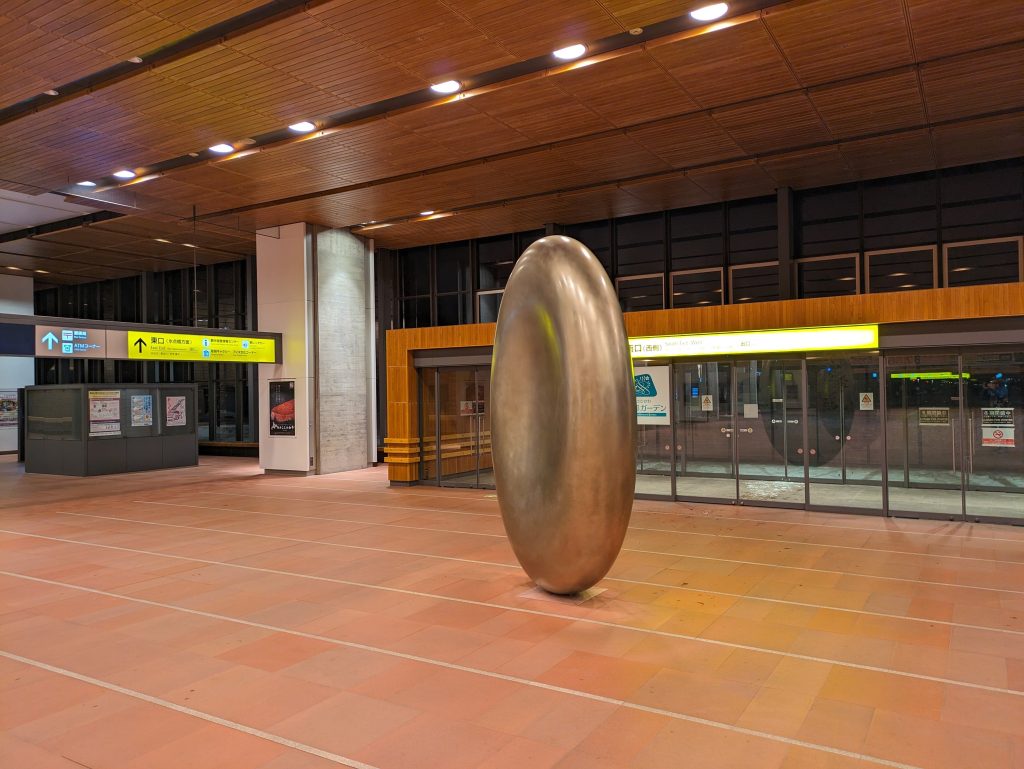
Oh, and there’s a giant flattened egg statue too. We love the giant egg. (Tenpi, by Kan Yasuda, meaning “Secret of Heaven”. See also the back view. He’s made a variety of these, all with the same title, some vertical like this and others arranged horizontally.)
Monday, December 30
Today’s transit:
Furano Line ‐ toward Furano
10:58 … 11:13 Furano
Nemuro Line ‐ toward Takikawa
12:15 … 13:36 Takikawa
Hakodate Line ‐ toward Iwamizawa
14:21 … 15:05 Iwamizawa
Muroran Line ‐ toward Tomakomai
16:32 … 17:01 Numanohata
Chitose Line ‐ toward Hoshimi
17:13 … 17:23 Minami-Chitose
Chitose Branch Line ‐ toward New Chitose Airport
17:27 … 17:42 New Chitose Airport
Chitose/Hakodate Line ‐ toward Sapporo
18:21 Sapporo
Today consisted “simply” of heading back to Sapporo, but the trip ended up being via some very roundabout routes, which I decided on a whim to take that morning. And, as expected, this is what let see some new places that I otherwise wouldn’t have traveled and ultimately have an even more fun, interesting, memorable day than just the straight shot back. :)
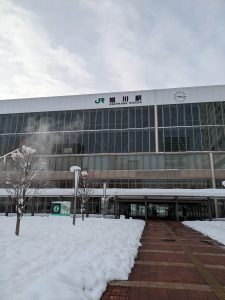
Instead of heading straight back to Sapporo, I last-minute decided to take a V-shaped route down to Furano and then back up & over to Takikawa, since I had time to kill and it’d show me some newer scenery than what I had already ridden (and already was going to be riding yet a third time in the new year…)
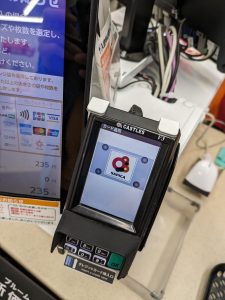
But first: stocking up on some snacks for the long local train trip back. Spotted SAPICA as one of the e-money payment options at Seicomart (exclusively!) This is the reason I don’t have it listed on my IC card page’s wall of shame – because you can use it to easily buy stuff at stores, not just for transit fare, instead of the balance going to waste.
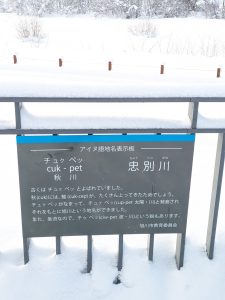
This sign discusses (a bit incorrectly) how Asahikawa got its name: It’s based on an Ainu place name (of course), “chiu pet”, that means “river of waves”. But this was misheard and mistranscribed by the Japanese as “chup pet” meaning “sun river”… which is the literal meaning of “asahi-kawa”.
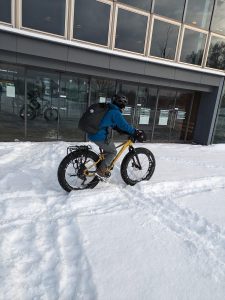
Remember: winter weather doesn’t cause people to bike less, bad cycling infrastructure does.
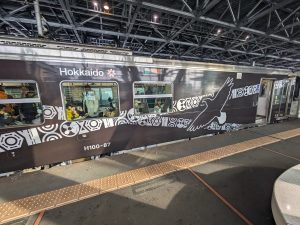
Alright, time for my train. This one wasn’t mine but was waiting on the opposing platform, decorated with multiple Ainu patterns and motifs.
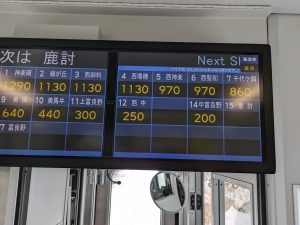
Remember above how I mentioned certain stations were closed and thus their corresponding numbers get skipped over? You can see that in action here on this in-train fare board.
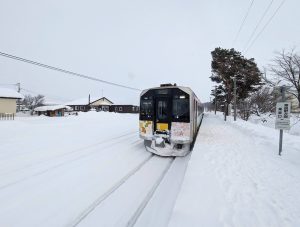
My train had a six-minute stop at Bibaushi Station, so I got out and took some photos. Love the pale colors of the front livery in the white snow.

I had about an hour wait here – perfect for a quick lunch! These sorts of gaps where you can naturally fit meals in are part of what makes local train travel so easy and great, in my eyes.

Takikawa was A JOY to walk around. 360° snow. Literal definition of a winter wonderland. I took so many photos here. Almost made me late while hurriedly walking back to catch my train!!
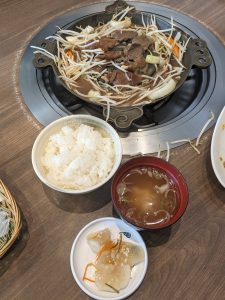
What I got for lunch, my first time eating a specialty of Hokkaido: Jingisukan! It’s grilled mutton, and yes, it is named after Genghis Khan… and no one really knows more than that, or not for sure, anyway.
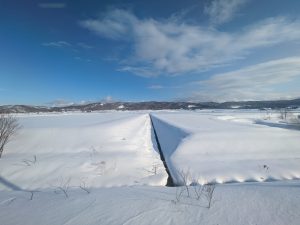
This next part of the ride was nice as well, through a lot of rice fields that appeared perfectly untouched and flat, apart from the canals running between the paddies.
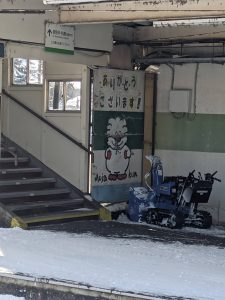
Found Moja-kun again!! Spotted him out the windows at a station on my train toward Iwamizawa/Sapporo. This time he was the official color.
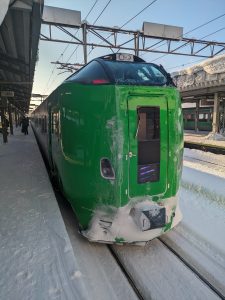
This limited express Lilac was hanging out at Iwamizawa. A lot of limited expresses travel this line, actually. Not for me, though, local trains only! :)
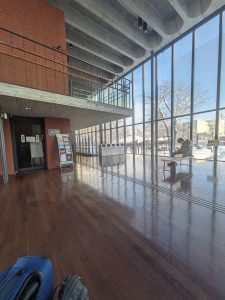
Found a spot to hang and charge my phone while I waited for my train. All the natural light coming in through these huge windows was great! The little pamphlet stand against the wall had a bunch of cool, free postcards advertising upcoming art exhibitions of local high school students.
This next section was so beautiful, so serene, light shining on the snow for miles as the sun slowly fell in the sky.

Decided to take one more detour on my way back, another V-shape down toward Tomakomai, and then up via near where the airport is in Chitose. Here was the sunset out a window of the unstaffed Numanohata Station.
This man with his decorated bike and Barbie dolls performed a rap for me and another local Japanese traveler at the station. We talked after – it was obvious that this guy probably wasn’t fully mentally “there” – but we agreed that people like this are what make life interesting, especially experiencing it on public transit, where you can encounter a variety of people and situations, all unique and interesting and memorable. And characters like him being in this world makes it a lot more rich than everyone “fitting in” and acting the same day-in, day-out.
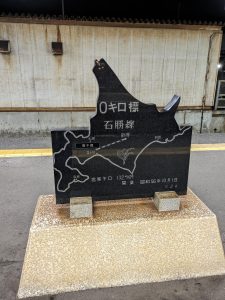
Found this 0 km marker at Minami-Chitose Station, marking the exact starting point of the Sekisho Line extending eastward from the station (one of the few lines I wasn’t able to ride, sadly).
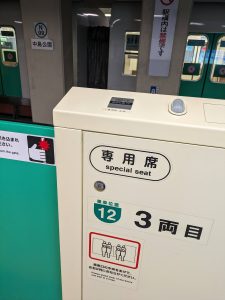
Made it back to Sapporo and decided to ride some subway lines around that night after dinner (which was soup curry). I like the translation they gave here for what usually gets rendered as “priority seat” (meant for seniors, disabled people, pregnant women, etc.)
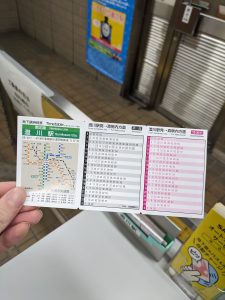
The Sapporo Municipal Subway still has mini paper timetables available at stations! Another one of my favorite features is how they have station guides showing you exactly which facilities – elevators, escalators, stairs – are located at which train car/stopping position at stations along the line, which can help you make faster transfers if needed.
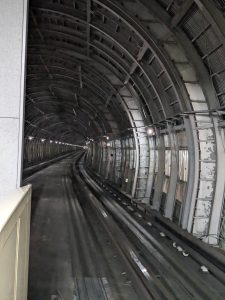
Sapporo’s subway is a rubber-tired system (ahh! gadgetbahn!) that, to protect it from the snow and better control the temperature, is fully enclosed – even its non-underground section shown here.

I rode around until late – until trains were mostly all done running for the night. This old-school sign was making a very loud on-and-off buzzing/beeping noise as a result.
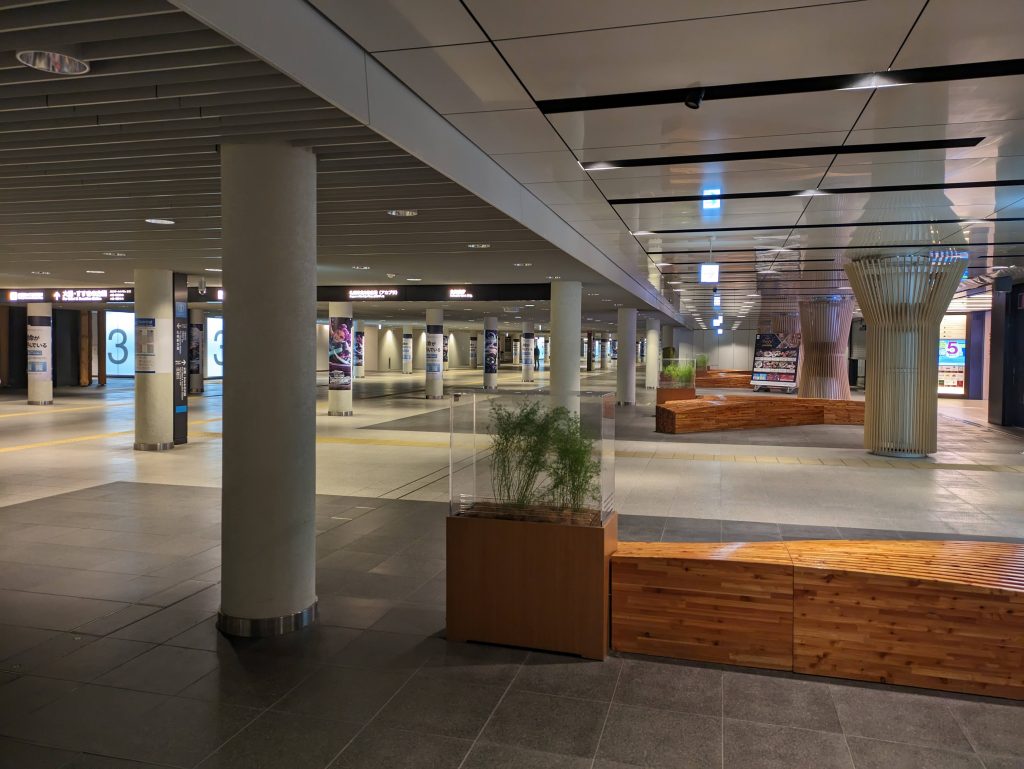
On my way to my hotel to check in and actually relax a bit more for the next few days. Sapporo obviously gets pretty cold and very snowy, so there are lots of underground walkways and malls (with places to sit and socialize, too) connecting everything, especially beneath the main Sapporo Station, Ōdori, and Susukino downtown areas. I looked on Google Maps and this walkway stretches for 15 blocks in one direction, and almost the same length in the other – 1¾ km total north-south, and just shy of that east-west as well!!
Tuesday, December 31
Today’s transit:
13:50 Sasshō Line ROYCE’ Town → 13:59 Tōbetsu
14:20 Sasshō Line Nagoya → 14:49 Sapporo
As expected, New Year’s Eve and New Year’s Day were both pretty chill. No real train-riding except for the the subway and streetcar, and a trip out to the ROYCE’ Chocolate factory. Their Nama Choco is the most delicious chocolate ever, seriously. Was a fun day trip on a quiet day when most people were inside or taking it easy, and then celebrating the countdown to 2025 at night.
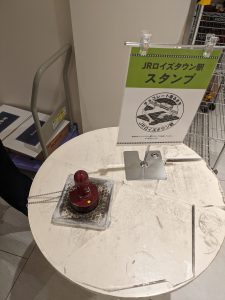
They had the eki-stamp not at the (unmanned) station but in the factory–museum itself! Although I had to ask – they said they didn’t have it out for the public anymore – and they brought this table out from the back. I know I didn’t technically get it at a train station, but it is the stamp for the station, so I still count it!
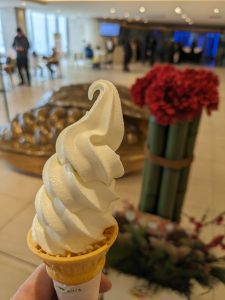
Got some delicious soft serve ice cream. The reader on the ticket machine even accepted SAPICA payments, too, not just regular (Mutual Use) IC cards.
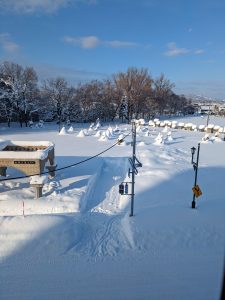
Decided to take the train down to (near) the end of the line, into the town of Tobetsu proper, which had some cool statues in the station before heading back.
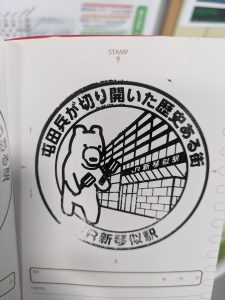
Stopped at some JR stations on the way back to get eki-stamps. This bear (holding spatulas???) was at Shin-Kotoni Station.
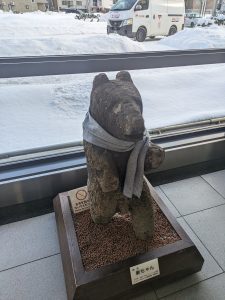
And here he is in the flesh (well, stone). His nickname is Shin-chan. I asked the gate staff for more information about them and they didn’t know, so I looked it up online and… literally no one knows how he got there. There was a plaque written by the stationmaster in the year 2000 asking people for information about him, such as who donated it to the station or when. Mystery bear! I love him.

I actually got off at Shin-Kotoni and walked a few blocks to the terminus of the subway’s Namboku Line so I could ride that around as well. I rode it pretty piecemeal, getting off and walking between different stops and lines. Here was a little low-key, end-of-year market going on at Suwa Shrine, nestled behind a post office between Kita 12-jo on the Namboku Line and Kita 13-jo-higashi on the Toho Line.
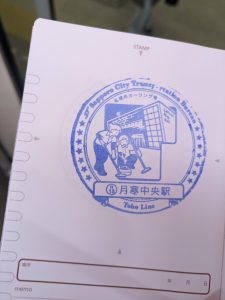
The eki-stamp at Tsukisamu Chuo Station, featuring curling, a popular winter sport where I grew up!! All the subway stamps use the ink color corresponding to the lines(s) that the station’s on, and the design uses a motif featuring the first letter of the station name – so, in this case, a ‘T’.
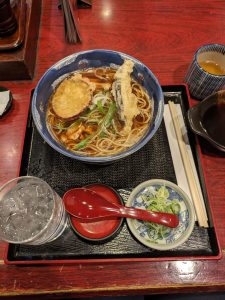
For dinner, I of course got toshikohi soba, “year-crossing soba” – signifying the hope of easily letting go of hardships from the previous year, just like how soba noodles are easy to break. Same NYE meal as last year. Same procedure as every year, James.
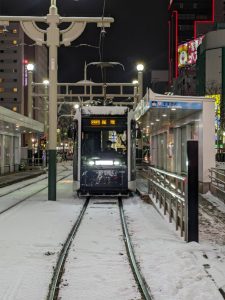
The streetcar system consists just of one loop, but legally it’s four different lines that form a loop. They were incomplete until they were joined together in 2015 – but in its heyday from the 1950s to the 70s, it had 11 lines and seven routes across the whole city, which eventually shrank due to – as always – cars. (As an aside, the word “streetcar” feels pretty US-centric to me, as a lot of other places call them trams, so it’s interesting that they’re indeed officially called streetcars in English here.)

It started snowing while I was riding!!! Such a great atmosphere, and I loved getting to watch out of the driver’s cab in the front. The first part of the ride was just me and some older women sitting near the front, and they were scared that I was choosing to stand up and ~possibly fall down~ instead of sitting, lol.
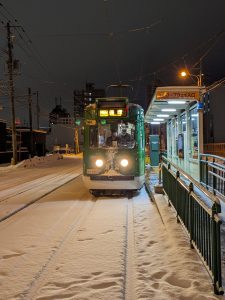
I got off just past the tram depot & operations center, for a very specific reason – and took this shot of the tram continuing on – before walking back to peer over the fence into the facility itself, to see…
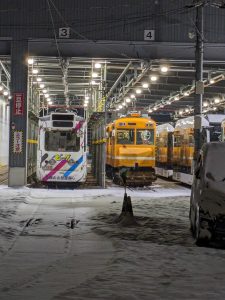
…the sasara densha, in yellow!!! This is a snow removal tram that they run just before the start of operations days when there’s been a lot of snow accumulation overnight. It has a rotary broom on the front, indeed made of thick bamboo bristles, and brushes snow off the tracks! I really wanted to see it running (and it indeed was the following morning, by chance) but the operation schedule isn’t public, much less decided for sure ahead of time, and I didn’t exactly want to wake up at 4 a.m. and wait around for hours in the cold just to possibly take a pic of it with my phone. But I did see it here in the depot!
Walking around at night, I came across some really great live music that I could hear from outside this bar. Just hung out and listened during the snowstorm.
And it REALLY started coming down. On the very last day of the year!!!!! Heaven.
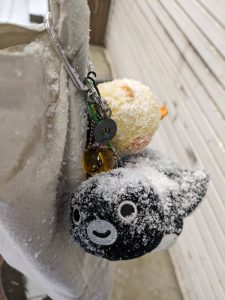
And my Suica’s Penguin pass case and other transit mascot plushies got pretty covered, too. Well, penguins do belong in the snow after all.
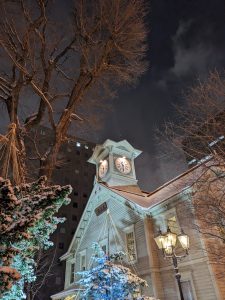
Went to see the Sapporo Clock Tower just before midnight. It’s the oldest clock tower in Japan, but most people think it’s pretty underwhelming these days – its old wooden exterior and two stories feel short and insignificant next to all the other tall, modern buildings built all around it. Which makes me like it and its quaintness even more.
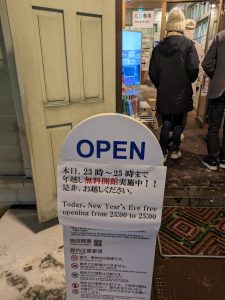
Turns out that admission was free for the few hours around midnight. I got to go in and poke around. I learned about how it’s one of the oldest buildings in Sapporo and still runs with its original machinery from 1881.
They had a computer set up to let you browse through archival materials about the history of the city, and of course I couldn’t help notice this amazing Windows XP screensaver. Japan’s most advanced computer.
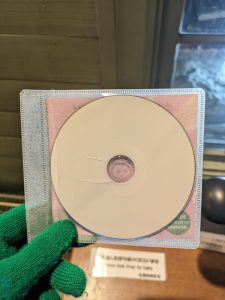
And to boot, I got given a CD of the songs that were playing on the second floor, which is set up with rows of pews, the former drill hall of Sapporo Agricultural College. The CD contained a local song, 時計台のある街 Tokeidai no aru machi, “The Town with a Clock Tower”.
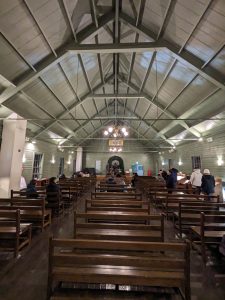
The ceremony hall on the second floor, which also had exhibitions on how the clock worked. The space gets used for concerts, lectures, and weddings.
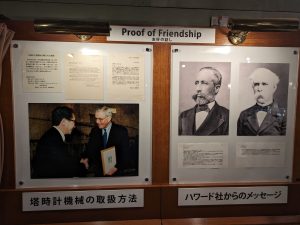
The president of Massachusetts Agricultural College was invited to be the vice-president of the school, the first of its type in Japan. These photos prove the “American–Hokkaido friendship!”
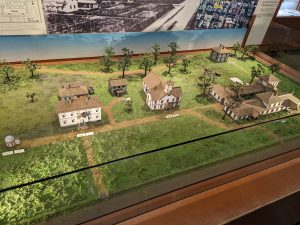
This is what Sapporo used to look like!! Here was the campus in the 19th century. On the walls around the exhibits, they had kids’ drawings from a bunch of local schools who were invited to color in drawings of the clock tower as they saw fit.
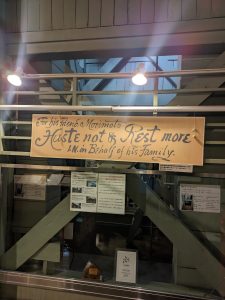
For his friend Morimoto – Haste not & Rest more. I.N., on behalf of his family. A good thing to do at the end of the year.
And finally: 3, 2, 1, Happy New Year!!!! A bunch of kids were counting down too and we all told each other akemashite omedetou! akeome!!! as the clocktower rang out. It’s 2025!!!
Wednesday, January 1
Today’s transit:
Today, on New Year’s, when people are home with family and most things are closed in the country, I went to two different parks: First, the municipal Moerenuma Park, a giant public park on the outskirts of the city with a lot of pieces by Isamu Noguchi in it, one of my favorite artists whose pieces I’ve seen around the world. In the afternoon, I headed to Shiroi Koibito Park, a theme park focusing on the other (besides ROYCE’) of Hokkaido’s famous snacks, the “White Lover” langue de chat cookies.
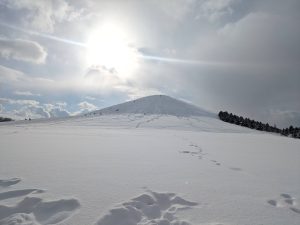
No skiiers in this part of the hill. Untouched snow. (Yes, I did take lots of pictures of the snow. Surprise.)

The snow was DEEP but luckily a couple other people had already walked out to it since the last snowfall… so following very carefully in their exact, very deep footsteps, I was able to walk up the mound too.
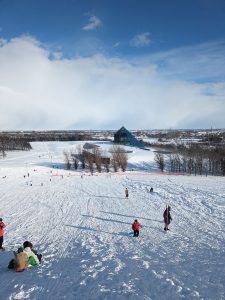
View from the top. You can see Noguchi’s glass pyramid “Hidamari” jutting out into the sky as well. In retrospect, I’m sad that I didn’t go see any of his play sculptures in the forest before leaving, which I don’t think I realized were there at the time. :(
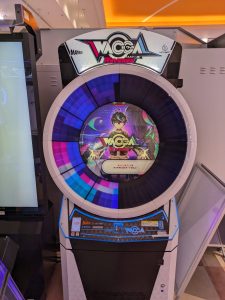
There was an arcade with WACCA (with half-broken LEDs) near Shiroi Koibito Park so I stopped by on my way back to the subway.

For dinner, I got hokke – Okhotsk atka mackerel, pretty much exclusively available in Hokkaido. This fish is yet another Hokkaido-related thing I learned about thanks to Splatoon, via the stage Port Mackerel’s Japanese name, Hokke Futō.
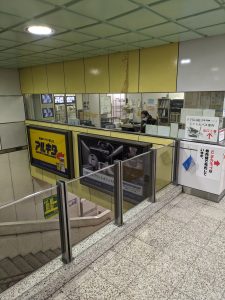
On the subway I found this ticket office that was located directly above the staircase down to the platform. Very odd placement!
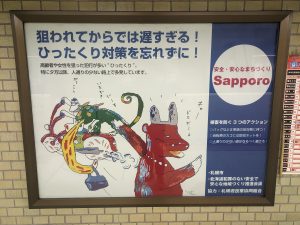
I loved this poster on the subway that was warning people about bag snatching. It’s illustrated by a local artist, 鯨森惣七 Cuziramori Souciti (or in Hepburn romanization, Kujiramori Soshichi). You can see more of his work here!
Thursday, January 2
Today’s transit:
10:05 Hakodate Line Asari → 10:15 Otaru
13:49 Hakodate Line Otaru → 15:08 Kutchan
15:16 Hakodate Line Kutchan → 16:26 Otaru
18:08 Hakodate Line Otaru → 18:14 Otaruchikkō
19:13 Hakodate Line Otaruchikkō → 19:26 Zenibako
19:52 Hakodate Line Zenibako → 19:57 Hoshioki
20:11 Hakodate Line Hoshioki → 20:30 Sōen
20:38 Hakodate Line Sōen → 20:42 Sapporo
20:53 Hakodate Line Sapporo → 20:55 Naebo
21:07 Hakodate Line Naebo → 21:23 Nopporo
21:34 Hakodate Line Nopporo → 21:38 Ebetsu
21:51 Hakodate Line Ebetsu → 22:16 Sapporo
Yes, I know the stops above look insane. I had a lot of time to kill today, so my idea of just a simple day trip Otaru turned into quite the expedition!
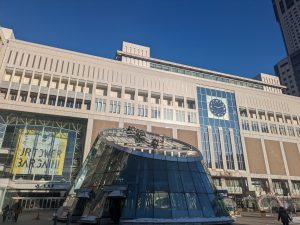
Totally clear, sunny morning in front of Sapporo Station. Headed to Otaru for a day trip! No real plans beside that, and only brief ideas for what to do there.
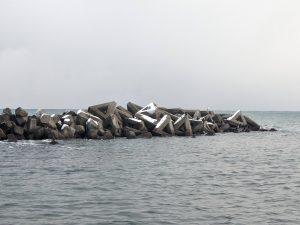
Lots of tetrahedron-shaped tetrapods on the way there, my favorite! I did some tetrapod sighting way back in April in Hokuriku, too.

I had something else to see up on the way to Otaru, though, marked by this sign at Asari Station… these weird automatic ticket gates, placed right up against the wall! This station became popular because it was a shooting location for an old Japanese film that got popular in China and Taiwan, so I guess with the number of visitors who would come via IC card they needed to provide a way for them to tap out and back in. They did also have ticket gates in the station building (no I don’t know what’s up with that sign or why they can’t support passes?) though so I’m not sure why these ones are strictly necessary.
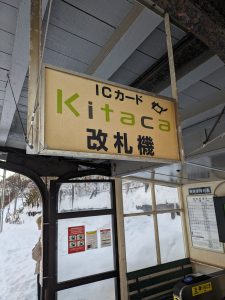
The unstaffed Asari Station even had a safety guard who walked around with a sign around his neck to tell people to stay away from the track because people repeatedly have gotten killed trying to take photos from restricted areas. Anyway, I came not because of the movie (I actually hate one of the director’s other films with a passion!) but because of the unique ticket gates, naturally.
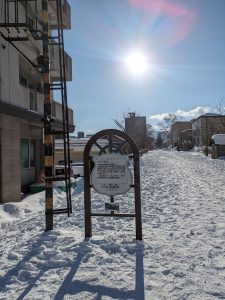
This was the path of the former Japanese National Railways Temiya Line (手宮線) which operated between 1880 and 1985. You can see the tracks when the snow’s not here.

Otaru is right on the bay and is famous for seafood, so of course I got a kaisendon, seafood donburi.
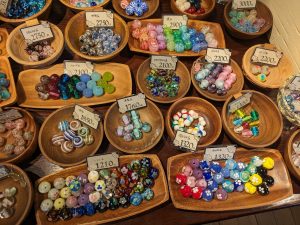
Otaru is also famous for glass production due to a shop in the early 1900s selling gas lamps. These owls were cute. I also saw old glass floats around town, historically used by Otaru’s fishermen and produced in the area.
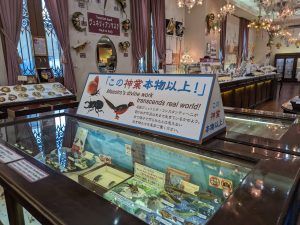
There were some seriously intricate, impressive glass creations. You weren’t supposed to take photos of the glass creations here… but I wanted a photo of this sign that told me about how Maestro’s divine work transcends real world.
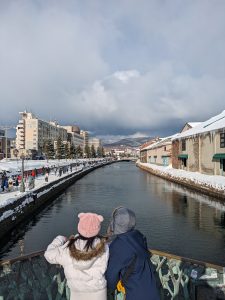
The Otaru Canal is nice, but I’m not sure why it’s so famous and talked about? It was OK! Just a canal!
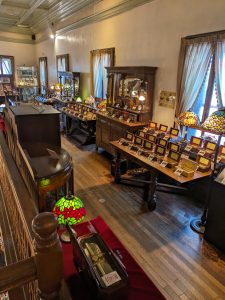
I went to the Otaru Music Box Museum which is exactly what it sounds like. They have thousands of different kinds of music boxes, from small to huge and modern to antique. It was pretty cool to look around.
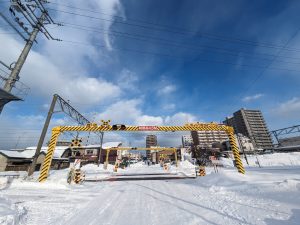
After grabbing the stamp from nearby Minami-Otaru Station, I still had about half the day left, so I decided to head over to Kutchan Station, the terminus of the next segment of the Hakodate Line, because this section of the local line will get shut down once the Hokkaido Shinkansen extension to Sapporo happens (although that won’t be for another decade-and-a-half now).
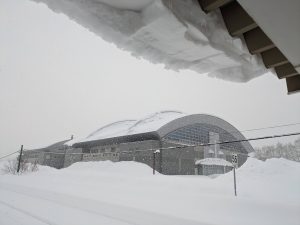
Kutchan is the gateway to all the ski resorts in Niseko and it was, fittingly, VERY snowy. There were a lot of people with ski and snowboard equipment on their train. I talked with an elderly woman who lives in the area and she thought we were probably the only two non-skiers on the train.
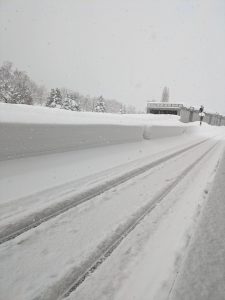
WONDERFUL SNOOOOWW. It was really coming down, too. The timetables were too sparse and slow to go back down to Oshamambe and loop back up, sadly, so I just turned back the way I came.
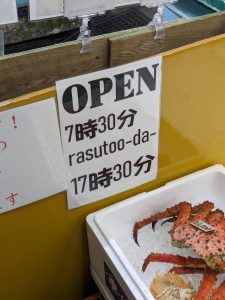
INCREDIBLE romanization of “last order” spotted at Sankaku Market, where I wandered around near closing time, after dinner, while waiting for my train onto the next section of the Hakodate Line.
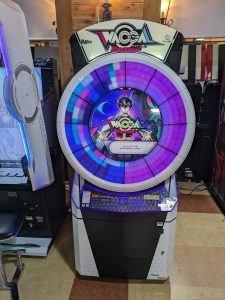
Got off at Otaruchikkō Station near the harbor to go play some WACCA. The cabinet’s LEDs were pretty good condition! The game has been removed at the vast majority of arcades across the country but there’s still a lot remaining in Hokkaido. The mall this place was in was kinda crazy.
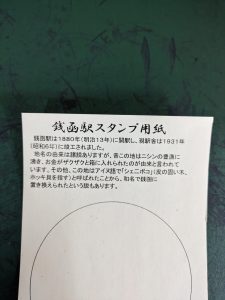
I got off at Zenibako, a curiously named station which means “money box”. The backing paper they provided for the eki-stamp talked about how the origin of the name is unknown, but many think it was after money boxes stored in fishing houses, which symbolized the area’s former prosperity during the herring fishing boom of the Meiji Period.
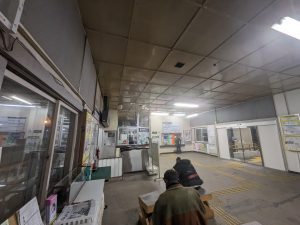
The station was old and unheated besides a gigantic area heater against the back wall (which I’m sitting directly in front of while taking this photo).
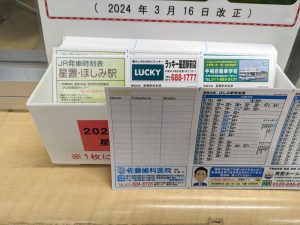
Not just the Sapporo subway – JR Hokkaido has mini paper timetables too! This one even has space for you to fill in an address book on the back page, with cells for home and mobile phone numbers… :D

This was one of the most spontaneous, magical finds of my trip – wandering around Hoshioki Station during a ~15 minute gap between trains, stumbling upon random staircase connected to the building, going up and across a short walkway, and then stepping outside and seeing this magnificent colored glass rainbow shining in the night. Brightening up a tiny little station in the middle of nowhere.
After my train arrived back in Sapporo and I picked up a few snacks from the in-station “Kiosk” store, I decided to continue on the line and grab a couple more eki-stamps before turning around and going back to my hotel to sleep.
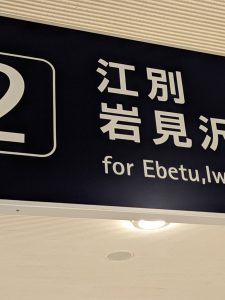
Kunrei-shiki romanization will never die!!!
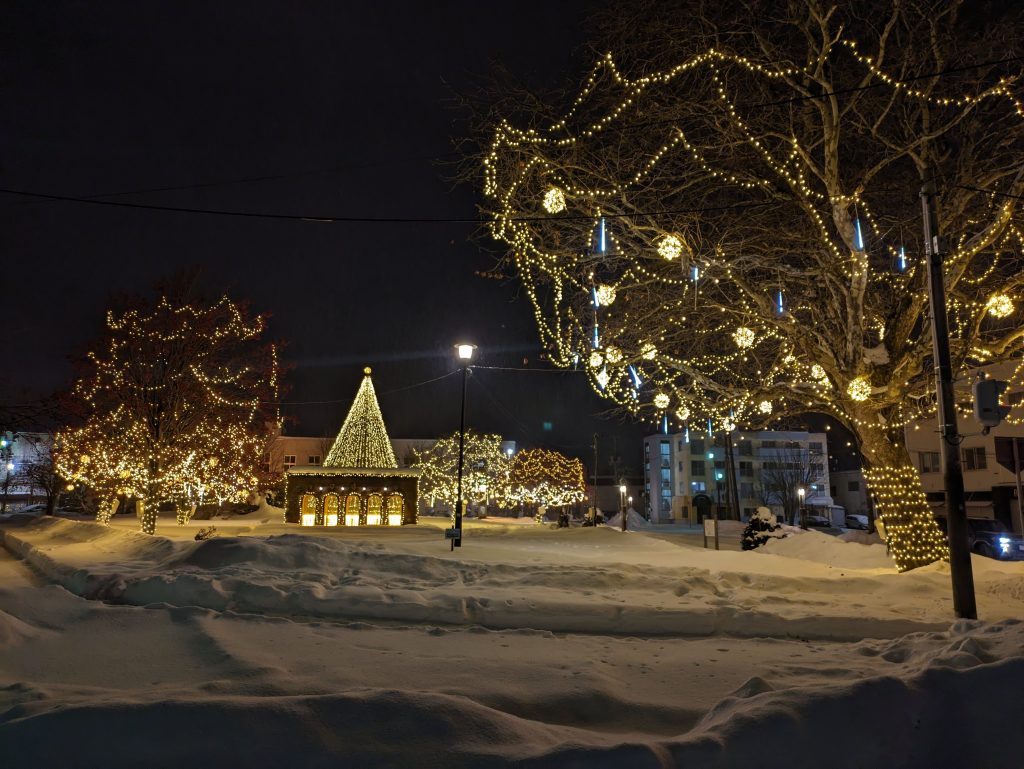
I stumbled upon another magical scene tonight just before turning around and heading back to Sapporo: this stunning, lit up park in front of the tiny, quiet Ebetsu Station. One of these photos taken closer to the brick fountain in the center is at the very top of this blogpost as it was one of my favorites from my entire trip. Ebetsu is known for bricks and there are hundreds of brick sculptures and building in the city.
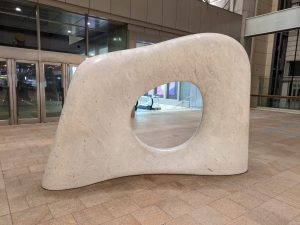
Finally back at Sapporo Station. I quite like this sculpture, titled Myōmu, or “strange dream”, which serves as a common meeting point at the station. It’s by a well-known artist from Hokkaido, Kan Yasuda… the same artist as that egg in Asahikawa Station!!!
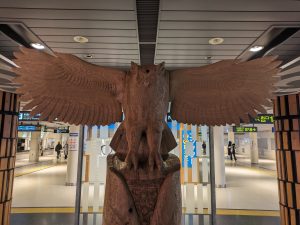
This wood carving in the walkway underneath the station is called IWOR-UN-PASE-KAMUY, by Ainu artist Toru Kaizawa. It means “Revered deity who protects each person’s sacred spaces”. I didn’t realize it at the time, but looking at my photos afterward, there was a small paper sign at the base, written in Japanese and English, unlike anything I’ve ever seen before in Japan. It read: “Please touch kindly, if you touch this statue.”
Friday, January 3
Today’s transit:
Hakodate Line ‐ toward Iwamizawa
11:47 … 12:03 Iwamizawa Station
Hakodate Line ‐ toward Asahikawa
13:37 … 14:40 Asahikawa Station
Sekihoku Line (Special Rapid Kitami) ‐ toward Kitami
18:01 Kitami
My second-to-last full day in Hokkaido consisted simply – actually, this time – just proceeding in a straight line to Kitami, a city in far northeastern Hokkaido and home to Japan’s both northernmost and easternmost IC card. Despite the simple route, needless to say, I had fun on the way.
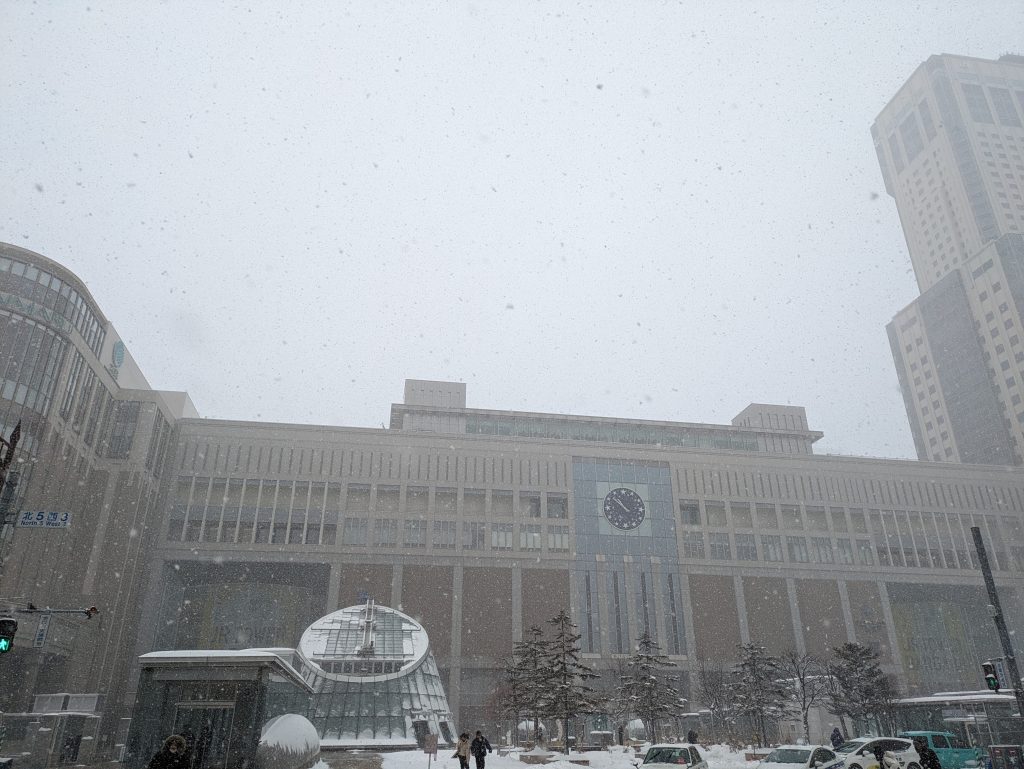
This morning was the snowiest it’s been so far. Check out the difference this morning from my similar picture 24 hours ago! Bye, Sapporo, for the last time!
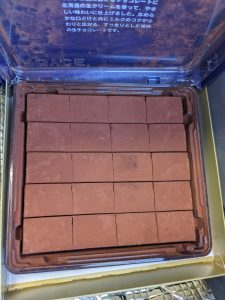
Stocked up on ROYCE’ Nama Chocolate. I mean, I did have 7 hours of trains ahead of me, I had to get some snacks…
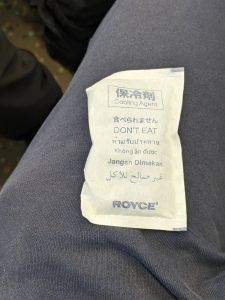
I received some ice packets in my insulated ROYCE’ bag, which came in handy a bit later on this train ride.
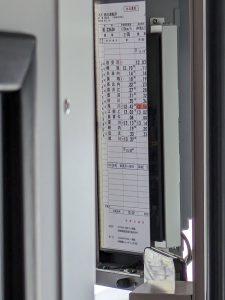
I like looking at the driver’s timetable posted in the front cab – the layout is nicer than the public Yahoo! Transit timetables on my phone – to tell me both arrival and departure times, which lets me know how long I have to potentially jump off at intermediary stations. Also, if you zoom in and look closely, notice what’s included in the departure times: seconds. The punctuality!!!! So thankful to be in a place with such amazing trains.
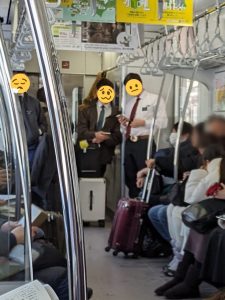
OK, this is one of my most hilarious stories ever, from the entire time I’ve lived here. Literally in the middle of nowhere, nothing around but farmland and vast distances between small houses, I see on my phone that there’s a Wi-Fi network available… called “JESUS❤️YOU”. Japan is less than 1% Christian. I am in the deep countryside. WTF IS GOING ON. Literally who or what out here could have done this. A couple minutes later, I look around my train randomly, and….. there they are, at the end of the train. Three. Mormon. Missionaries.
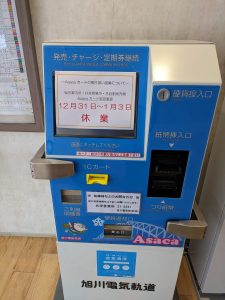
Layover in Asahikawa. And this is exactly why I had to come here before: The Asaca vending machine and counters are fully shut down during the New Year’s period!!!
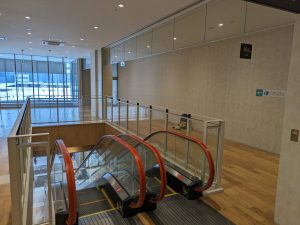
I hung out in the random second floor of the bus center as I waited for my next (long) train amid all-closed dental clinics and cram school facilities. I ate my salmon ekiben for lunch and charged my phone in the wall outlet which was surely not allowed (because Japan) but I needed the juice and no one was around to yell at me. :) You can see my stuff against the wall. I thought it was funny how barren it was up here. Seriously, so wide open and empty and deserted…
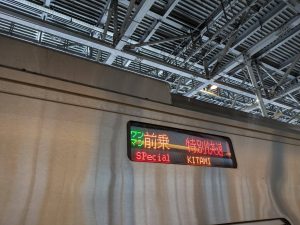
Onto my very last major destination of the trip, on the one-a-day special rapid “Kitami” train, bound for, you guessed it, Kitami. I really liked how it scrolled in two parts. (The following March, it was downgraded to only being a rapid, rather than special rapid, so this is now a ~rare~ headsign photo, I guess.)
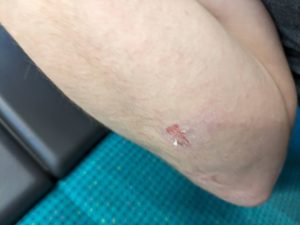
Who among us has not wanted to get the eki-stamp from Kamikawa Station? Who among us has not decided this was possible with a two-minute stop, despite the station building being on the other island platform? Who among us, I ask, has not decided it was worth leaving all your belongings including jacket on the train (the only one that comes for the next two hours), then bounding up the stairs, over, back down, slipping on ice, falling on the ground, sliding and crashing into the metal sliding door of the station office, significantly horrifying the staff and small amount of passengers, not even explaining what ticket you’re riding on, asking for the stamp and having a shaky finger point to it, stamping it post-haste and then bounding back onto your train as the doors close behind you? This is assuredly a universal experience. Anyway… my elbow hurt for days. At least I had some ice packs with me…
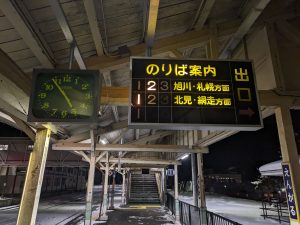
The train did a switchback at Engaru Station which had these super old, Japanese National Railways-era lighted station guidance signs. Depending on which platform the next train in each direction is arriving, different numbers light up. I saw a tweet last month where someone else was talking about the retro appeal of these disappearing signs and also mentioned how the station name sign is installed perpendicular to the platform rather than parallel to it. More old-fashioned, rare aspects and features!

I really liked this hand-painted sign, too, especially with the English uniquely spread across two lines. So much character!
It was getting very cold. As proved by my breath.

Arrived into Kitami, which has a strong association with curling! The Wikipedia article has a brief history of the city’s relationship with the sport; it was home to Japan’s first curling hall, built in 1988, and many Winter Olympians have come from Kitami. The mailbox here has a curling stone (or rock) atop it.
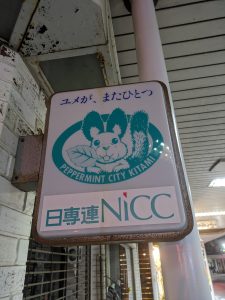
I learned that Kitami also is very much associated with mint. Production peaked in the prewar era of the 1930s, and at that time it actually accounted for 70% of all the mint in the world. There’s a building called the Mint Memorial Hall I read about online – but I’d only ever seen the name in English, and when I went to their website… I was surprised to find that it wasn’t about money!! Sadly, it was closed during the days I was there, but to make up for it, Kitami does sell wonderful, delicious mint langue de chat cookies – hands-down better than Shiroi Koibito – in the shop in the station. (NB: You can also get them at the Hokkaido Dosanko Plaza in Yurakocho, Tokyo…)
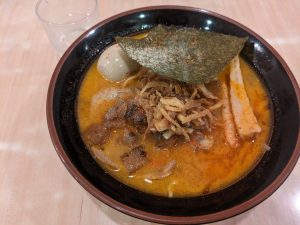
I’m not that big on ramen, but it is very hot soup, fast and readily available, and it was a very cold night, so… I showed up to a place near-ish my hotel at just before 10 p.m. and ordered their signature “Kitami onion miso ramen”. Kitami, I learned, is also famous for onions – they’re Japan’s top producer of them. Onions are the new mint, as they say.
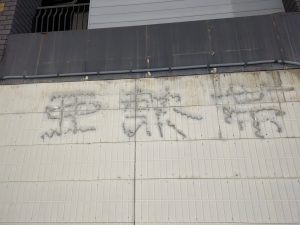
Lots of old, dilapidated buildings and worn out, faded, or straight-up removed signs in Kitami. I think this isn’t graffiti or anything, but rather a stencil that was drawn to show where some neon or similar signage was to be installed… which, now, has all been removed.

Random Hawaiʻi-themed place??? Next time I go back to Honoulu I will announce: “I spread new culture. I take trip to the world sea.”
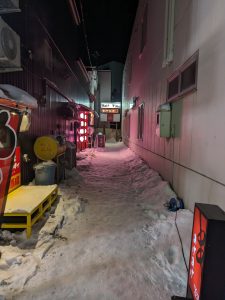
Liked this little lit-up alleyway. Maybe not as ~aesthetic~ as the one in Asahikawa, but it’s hard to not like neon + snow, two of life’s greats.

Public shovels!! …Well, OK, probably not, I got the sense they likely just belonged to this business. But they reminded me of the ones I saw up in Toyama.
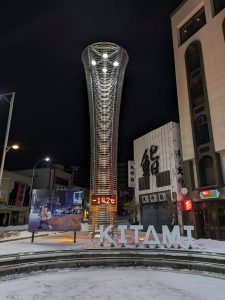
I walked around to explore the town at night but it was absolutely, truly, bone-chillingly cold. (I know it wasn’t even 0°F, but it really did feel colder than that, I’ve gotta say.) When I walked by this sculpture again the temperature was even lower but it was too cold to take out my phone and snap a pic. Very ironically, I forgot my winter gloves at home, and didn’t have them on this trip… but I did have my rhythm game gloves for WACCA, and then bought a second pair at a Seicomart, and layering the two worked well enough.
Saturday, January 4
Today’s transit:
15:19 Senmo Line Katsuradai → 16:03 Shiretoko-Shari
16:35 Senmo Line Shiretoko-Shari → 17:18 Abashiri
17:47 Sekihoku Line Abashiri → 18:47 Kitami
My final full day, I didn’t have much to do besides poke around Kitami, with no real plan in mind… but the city itself was pretty dead, and even the Mint Museum was closed, so I decided to take the Sekihoku Line to Abashiri, all the way to the end. Abashiri is famous for being the location of the maximum security Abashiri Prison, which has had a few notable inmates, most famously Yoshie Shiratori, the only prisoner to have ever escaped… which he also did three more times at three additional prisons. Abashiri is also right on the Sea of Okhotsk, a famous site to see drift ice, albeit a bit later in the year compared to when I was there. I decided to ride the Senmo Line too – one of the lines facing potential-to-probable closure in the future – out to the base of Shiretoko National Park, as far as I could go before needing to head back (on very sparse timetables) and make it home by night.
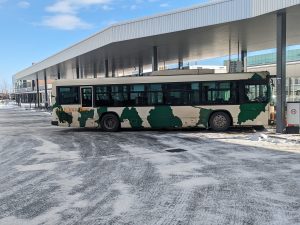
I like the livery of Hokkaido Kitami Bus buses! Although the driver yelled at me because I stepped one foot off the sidewalk to take this photo which was apparently “dangerous” lmao, OK.
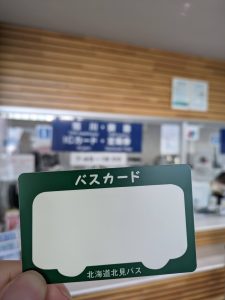
The bus center was closed by the time I arrived the previous night, but I bought the IC card I came here for, the last one I planned to get on my trip: Bus Card!!! (Also known as IC Bus Card” They’re not exactly consistent with the naming…)
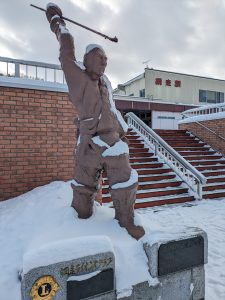
Outside of Abashiri Station stands this statue of a Moroyo fisherman, referencing the largely unknown people of the Okhotsk culture 1300 years ago.
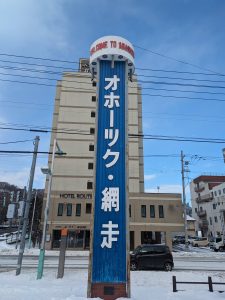
Welcome to Abashiri, Okhotsk Subprefecture, the city in Japan with purportedly the least amount of rain. Ironically, the “foot” of the ‘shiri’ kanji in its name (走, which means “run”) is missing.
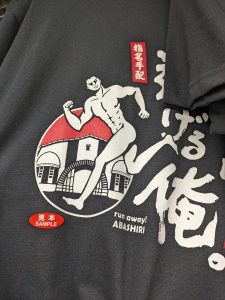
I wonder how the prison feels about the fact that “this guy broke out!” is used so heavily to advertise Abashiri. Anyway, this guy looks like he came straight out of Thermae Romae.
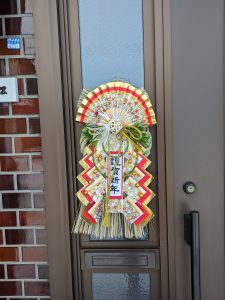
Just as I highlighted during my trip last winter, there were many shimekazari up in the first few days of the year.
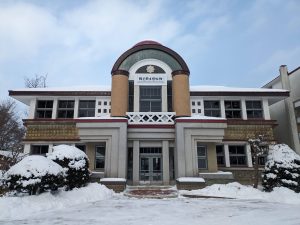
I decided to go to the Abashiri City Folk Museum, a local history museum with displays of items excavated from the Moyoro Shell Mound archaeological site, animals found in the area, etc.
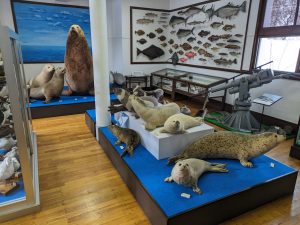
I was the only person in the museum and there was NO HEAT, so I spent a lot of time – going back and forth, back and forth – in the taxidermy room which had a large radiator in the corner.
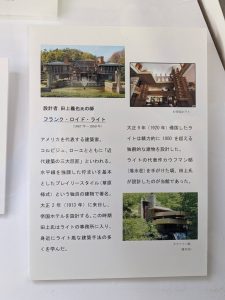
The museum building was – much to my surprise – designed by an architect who was a pupil of Frank Lloyd Wright, who is from my home state of Wisconsin!
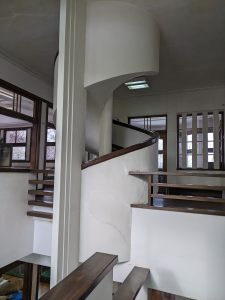
Frank Lloyd Wright worked in Japan for six years in the 1910s and 1920s, which I didn’t know previously. This building was constructed in a style that was meant to emulate his, or carry on his legacy. Sadly this spiral staircase in the center was staff-only.
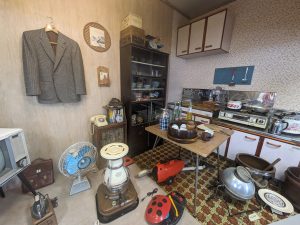
Various items exhibited in the museum. The whole history of the area was traced out, from the Paleolithic to the period this kitchen represents, the Showa era (1926–1989).
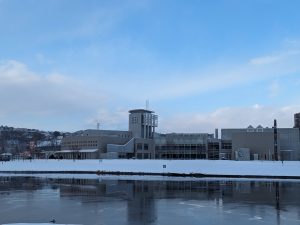
I wandered around the city waiting for my next train and visited the local public library, an interestingly shaped building on the river. Like the weather, the staff were cold. This is definitely one of the areas that’s felt the most “dead” to me in Japan.
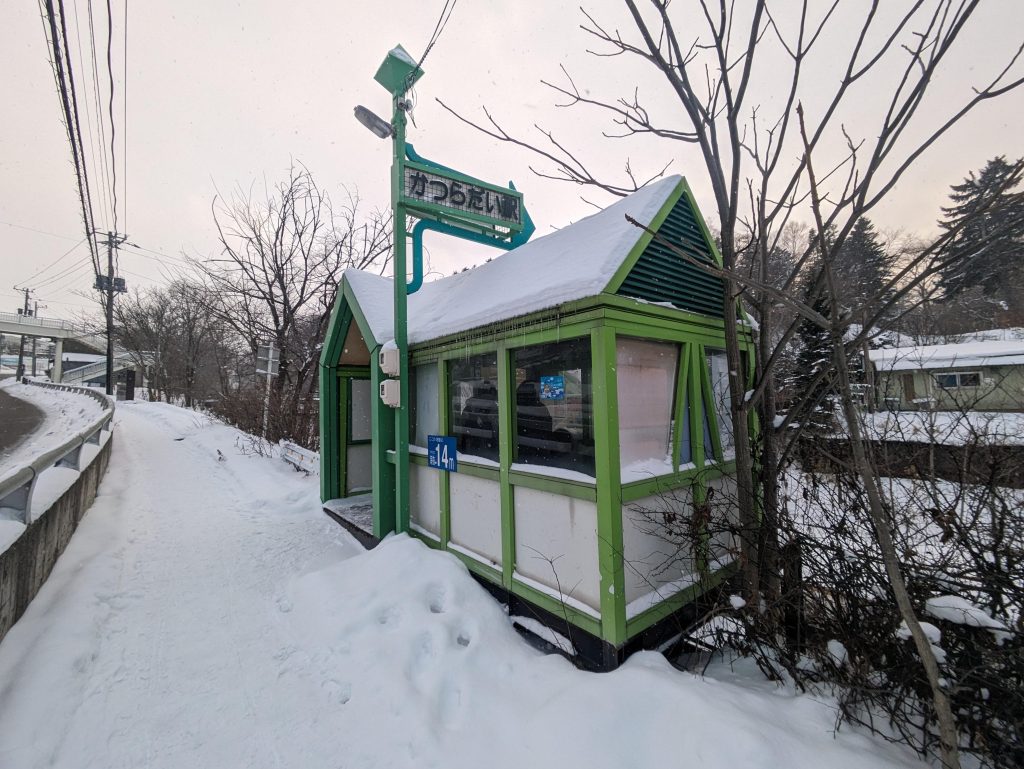
At the nicely colored Katsuradai Station – more of just a hut with a few walls and a staircase – waiting for my last “new” (taking me to a place I hadn’t been before) train. In total, I rode over 1400 km of rail over the course of this week in Hokkaido!
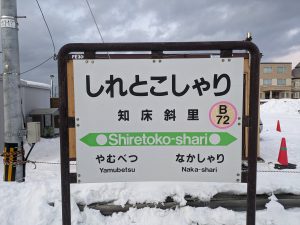
Arrived at the easternmost station of this line (with station numbering beginning with ‘B’ for some reason)… but not quite of all of Hokkaido. Hope to make it out to Nemuro someday!
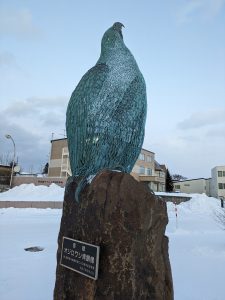
A very cool bronze, latticed statue with a patina depicting a white-tailed eagle outside Shiretoko-Shari.
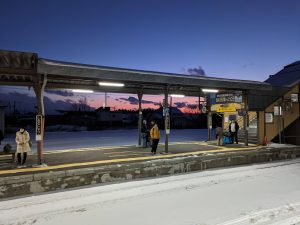
Did just a quick turnaround here. Walked to Seicomart for a snack and then back. Nice sunset on the platform as I waited for my train home.

Sat across from this guy in the train, decked out head-to-toe in Gochuumon wa Usagi desu ka? merch. He was happy I took an interest in his hobby (obsession?) and happily posed when I asked for a photo of his whole setup. I forget if he was doing some seichi junrei to this place in particular or not…
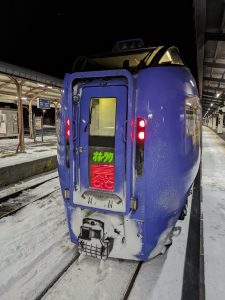
If you hadn’t picked up on the pattern by now, there’s a lot of stuff named Okhotsk out here (like this limited express train too). It’s nice to see Japan embracing what are essentially foreign culture and words.
Sunday, January 5
Today’s transit:
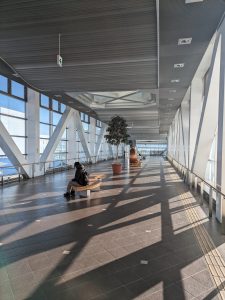
I didn’t have much to do besides wait for my 2-ish p.m. bus to the airport for my 3:30-ish flight – arriving thirty minutes prior to t, ample time up here in the Kitami – so I wandered around, including through the promenade–walkway attached to the station.
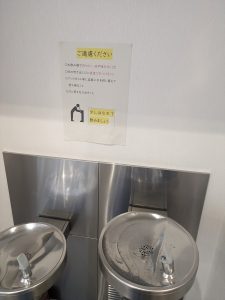
As I filled up my water bottle at this drinking fountain, I read the sign: Please refrain from taking home water by transferring it to plastic bottles and other container. Why? Because fuck you, that’s why. Dejectedly, I dumped out my water… hahahahaha, just kidding, no I didn’t, I laughed at the insanity that permeates this country and filled up the rest of my water bottle. Deportation coming in 3, 2…
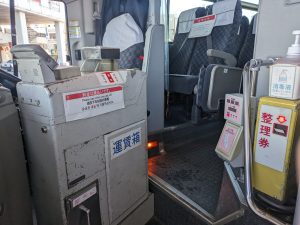
Kitami Hokkaido Bus’ IC card isn’t refundable, but at least I got to use up some of the balance on my way to Memanbetsu Airport instead of letting it go to waste!
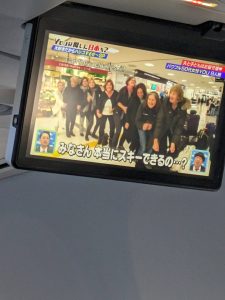
I watched an episode of TV Tokyo’s YOU wa nani shi ni Niippon e? (“Why Did YOU Come to Japan?”) on the plane which involved reporters interviewing and following around this 9-person group of women who came from Australia to ski.

57-year-old Mary Ann was the “leader” of the group. My favorite thing about this program is that when they record from a distance, all of the featured people are labeled with an arrow and text hovering over them reading “YOU” – all-caps, written in romaji just like that, such a hilarious, inventive use of language. Japan knows no rules when it comes to pronouns, or the fact that most languages have those as closed class of words, and I love the playfulness.
I got home, right-away grabbed some tonkatsu for dinner with a friend from my IC card collecting Discord server who was passing through Nagoya just that night – and then finally, I got some sleep.
Next up… well, a new IC card debut is on the horizon, and I’m not done spending time in the snow quite yet! :D

